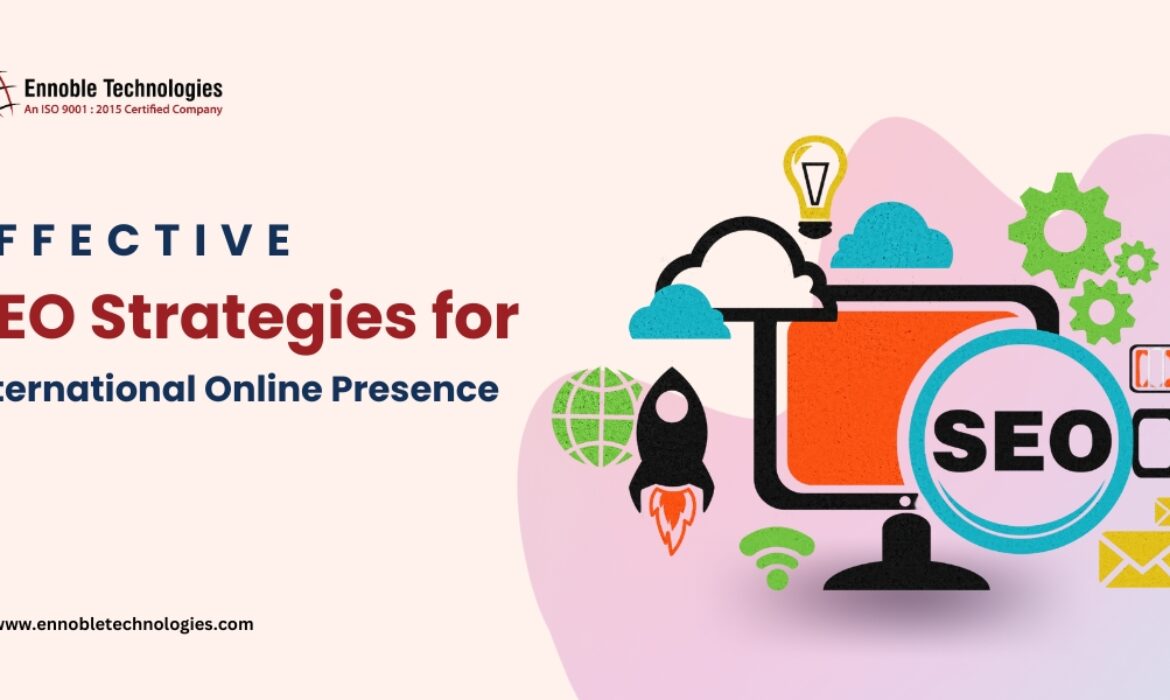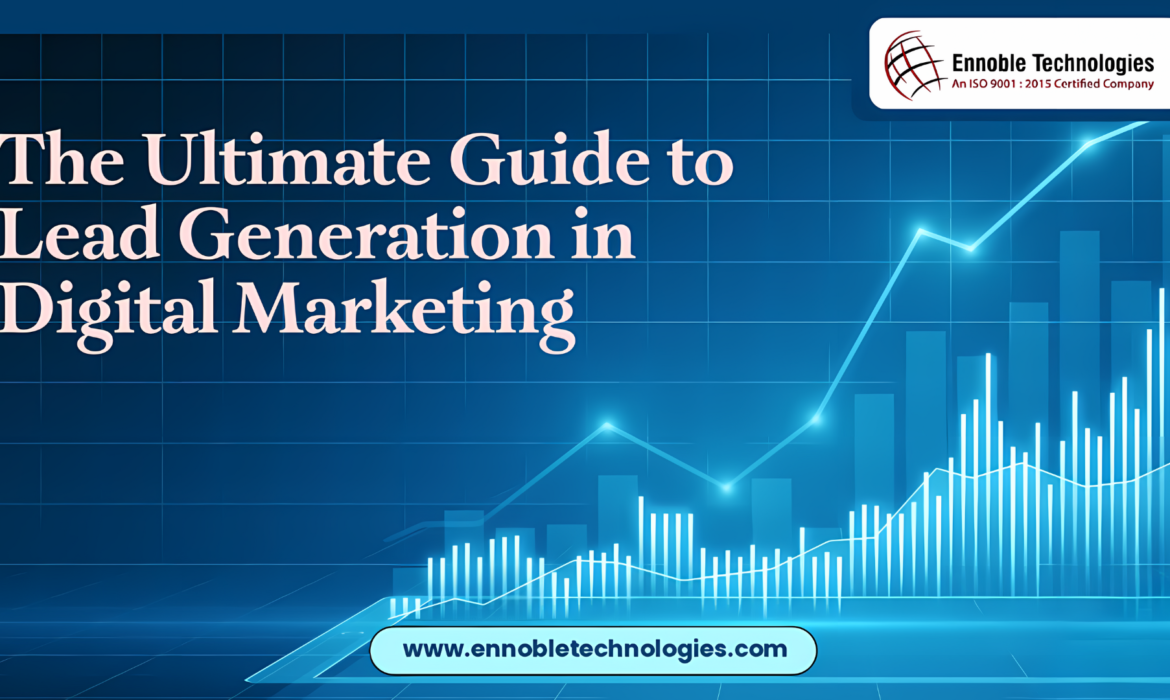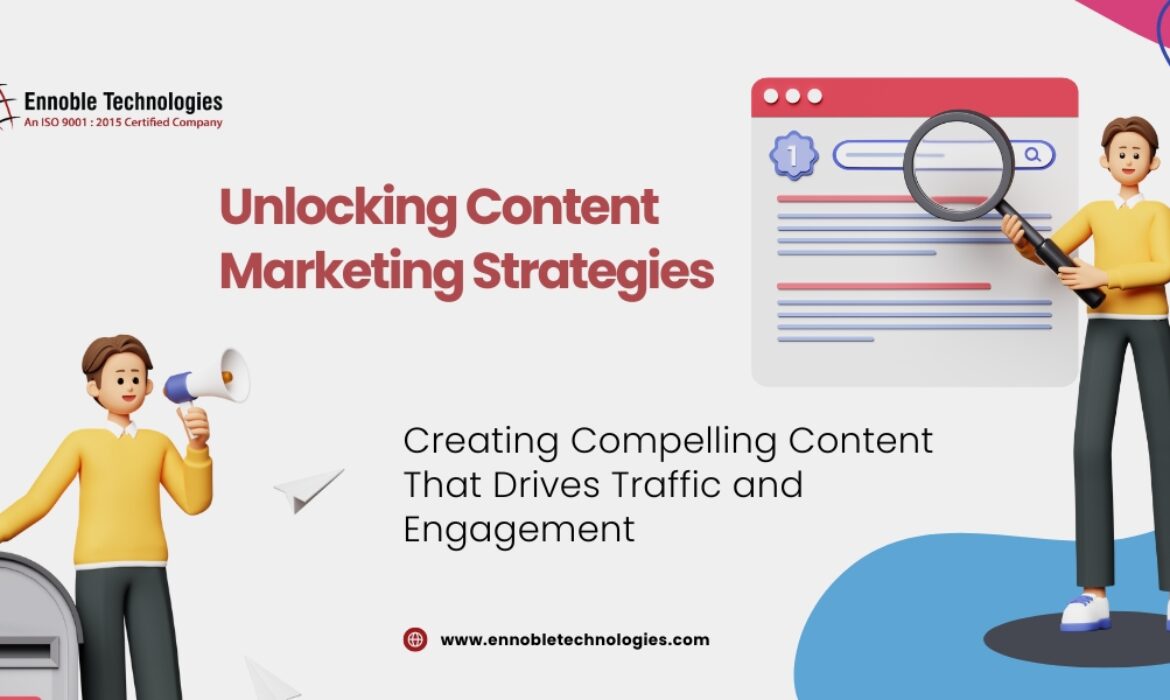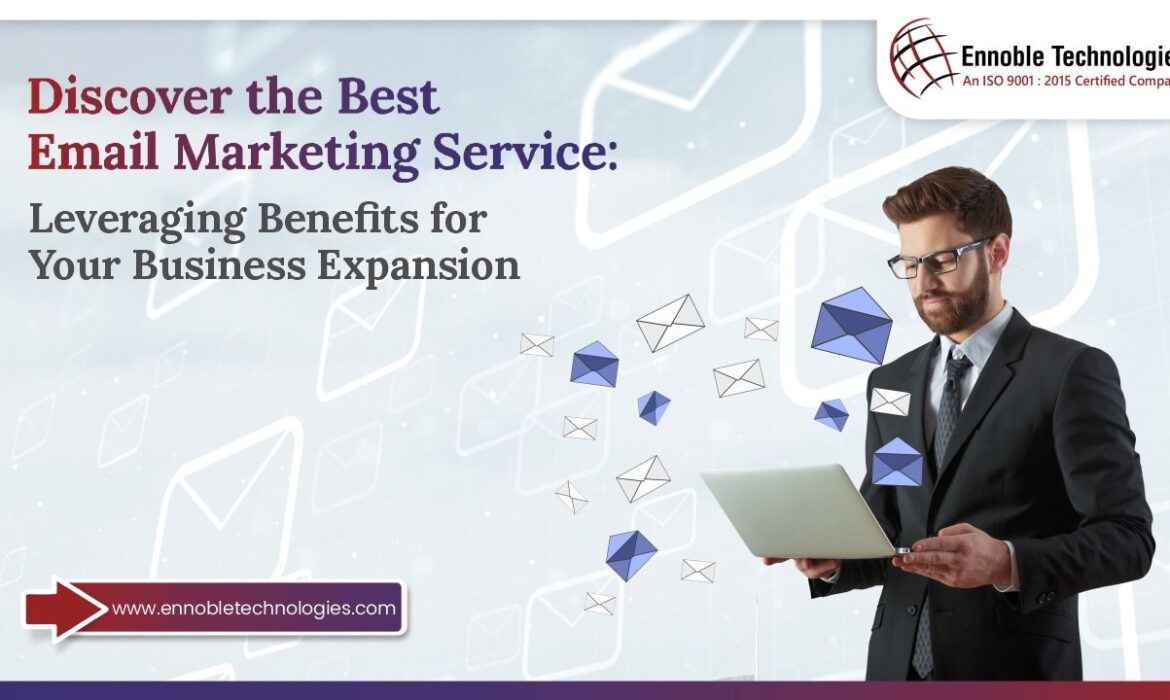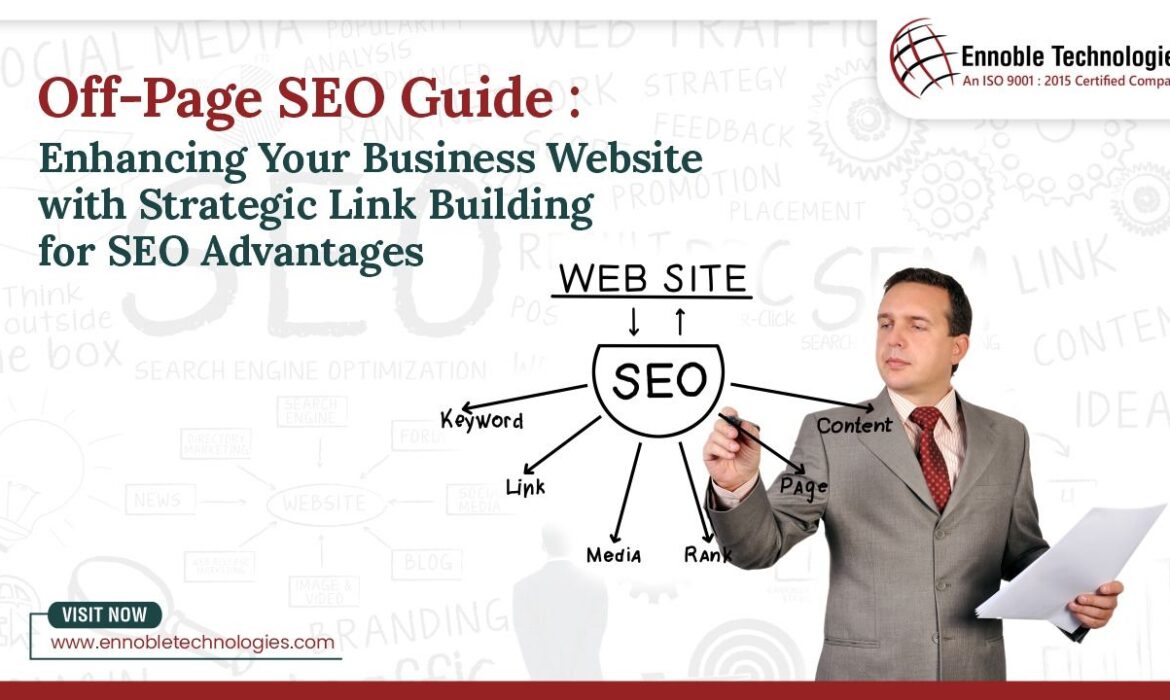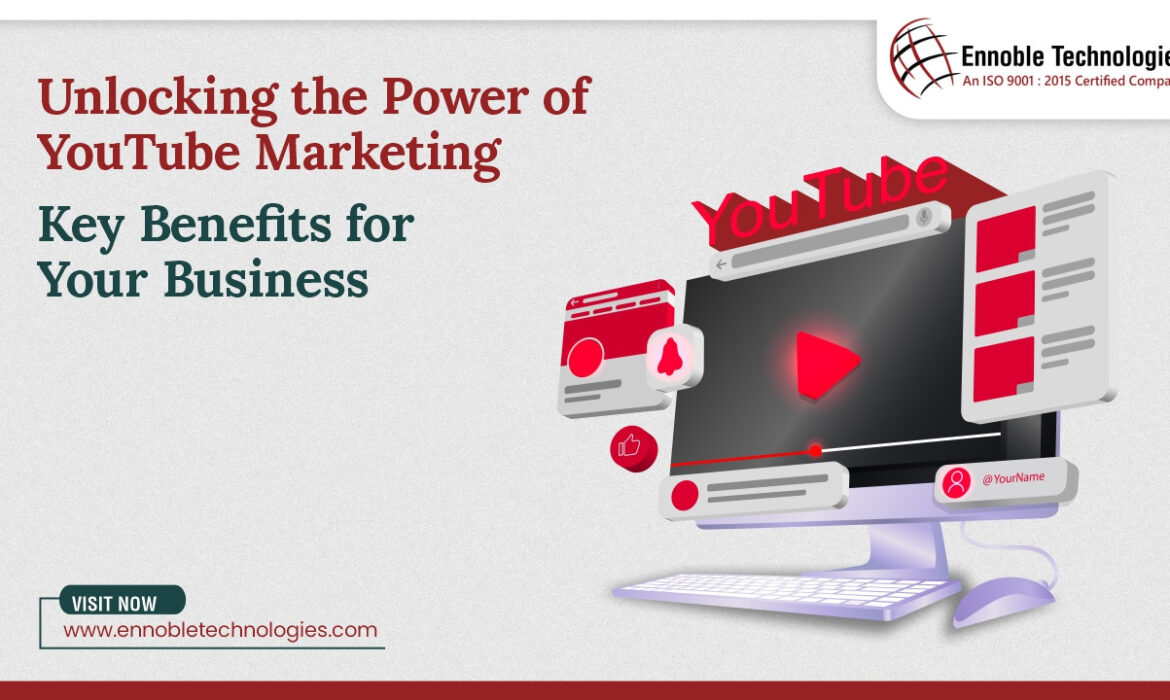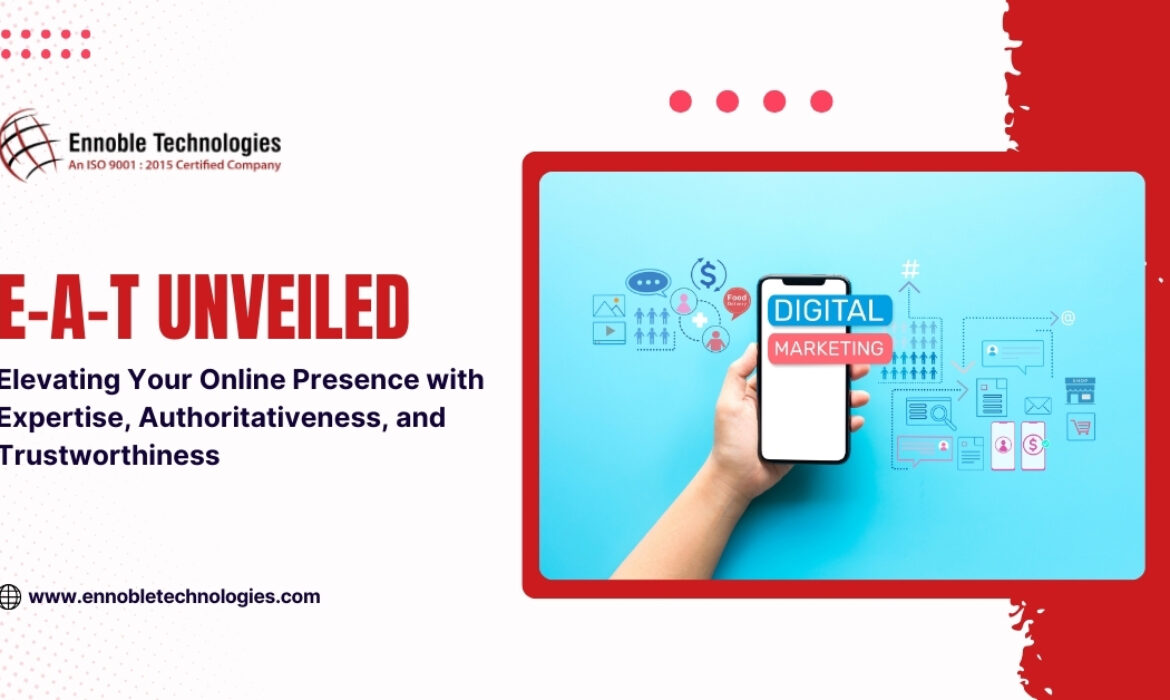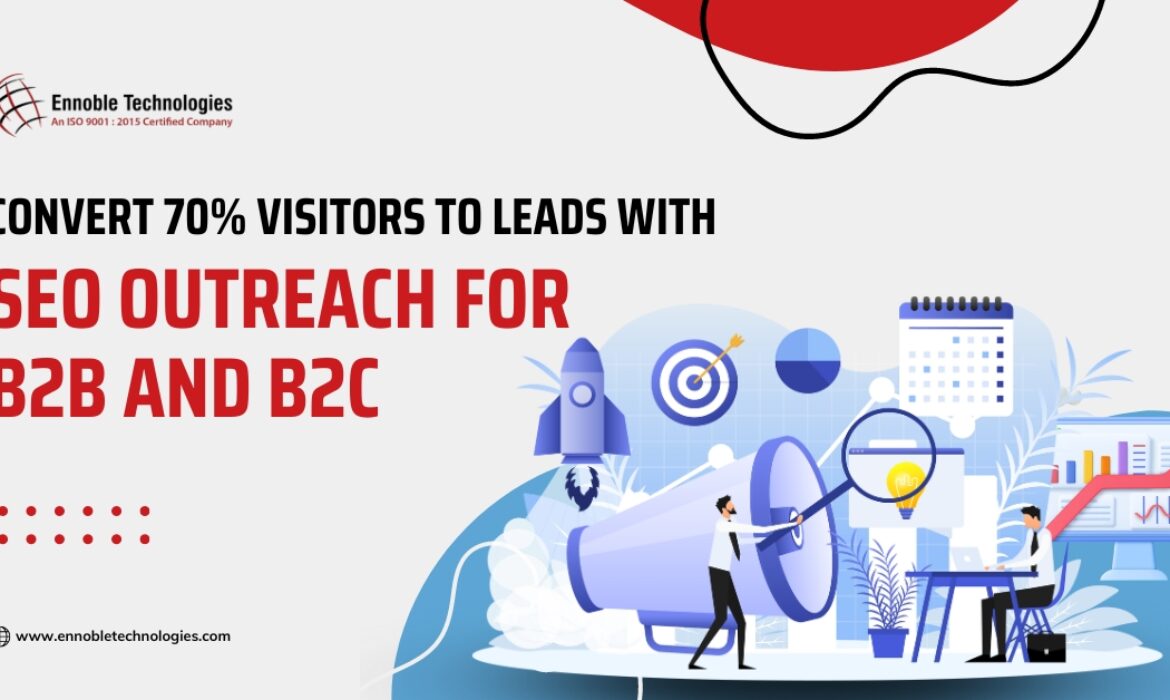Effective SEO Strategies for International Online Presence
In today’s interconnected world, businesses are no longer confined to their local markets. To thrive, companies must expand their reach to international audiences. Effective SEO strategies play a crucial role in achieving a robust online presence across different regions. At Ennoble Technologies, we specialize in providing top-notch global search engine optimization services that cater to diverse cultural and linguistic needs. In this blog, we’ll explore international SEO techniques and SEO best practices to help your business succeed on the global stage.
Understanding the Importance of International SEO
International SEO techniques are essential for businesses aiming to attract and engage customers worldwide. Unlike traditional SEO, which focuses on optimizing a website for a single country or language, global search engine optimization requires a more nuanced approach. This involves adapting your content, keywords, and overall strategy to meet the needs of different regions.
Multilingual SEO Strategies
One of the most important aspects of effective SEO strategies for international markets is the implementation of multilingual SEO strategies. This involves translating and localizing your website’s content to cater to various languages spoken by your target audience. At Ennoble Technologies, we understand the importance of providing accurate and culturally relevant translations to enhance user experience and improve search engine rankings.

Benefits of Multilingual SEO:
- Enhanced User Experience: Offering content in multiple languages makes it easier for users to understand and engage with your website.
- Increased Traffic: By catering to a broader audience, you can attract more visitors from different regions.
- Higher Conversion Rates: When users can access information in their native language, they are more likely to convert into customers.
SEO Best Practices for Different Regions
Implementing SEO best practices for different regions is crucial for the success of your international SEO efforts. Each region has its own unique search behaviors, preferences, and trends. At Ennoble Technologies, we tailor our effective SEO strategies to meet the specific needs of each market.
Key Considerations:
- Keyword Research: Conduct thorough keyword research to identify the most relevant terms for each region. This includes understanding local search intent and preferences.
- Content Localization: Adapt your content to reflect the cultural and linguistic nuances of each region. This goes beyond translation and involves customizing your messaging to resonate with local audiences.
- Technical SEO: Ensure that your website’s technical elements, such as hreflang tags, URL structures, and mobile optimization, are set up correctly for international SEO.
Leveraging SEO Analytics Tools

To measure the success of your effective SEO strategies, it’s essential to utilize SEO analytics tools. These tools provide valuable insights into your website’s performance, user behavior, and search engine rankings across different regions.
Essential SEO Analytics Tools:
- Google Analytics: Track website traffic, user demographics, and conversion rates.
- Google Search Console: Monitor your website’s presence in search results and identify any issues.
- Ahrefs: Analyze backlinks, keyword rankings, and competitor performance.
- SEMrush: Conduct comprehensive keyword research and track your SEO progress.
At Ennoble Technologies, we leverage these tools to provide our clients with data-driven insights and actionable recommendations. This enables us to continuously optimize our global search engine optimization efforts and achieve better results.
Cross-Border SEO Solutions
Expanding your online presence to international markets requires a strategic approach to cross-border SEO solutions. Ennoble Technologies offers a range of services designed to help businesses overcome the challenges of international SEO and achieve their goals.
Our Cross-Border SEO Solutions Include:
- Market Research: Conduct in-depth research to understand the target market’s needs, preferences, and competition.
- Content Strategy: Develop a content strategy that aligns with the cultural and linguistic requirements of each region.
- Link Building: Build high-quality backlinks from reputable websites in different regions to boost your website’s authority.
- Local SEO: Optimize your website for local search engines and directories to improve visibility in specific markets.
Regional SEO Strategies
Implementing regional SEO strategies is vital for businesses looking to establish a strong presence in specific geographic areas. Ennoble Technologies excels in creating customized effective SEO strategies that cater to the unique needs of different regions.
Key Elements of Regional SEO:
- Local Keywords: Identify and target keywords that are specific to the region you are targeting.
- Localized Content: Create content that addresses the interests and concerns of the local audience.
- Local Backlinks: Acquire backlinks from local websites and directories to improve your website’s authority in the region.
- Google My Business: Optimize your Google My Business profile to enhance local search visibility.
Multicultural SEO Services

Catering to a diverse audience requires a deep understanding of cultural differences and preferences. Ennoble Technologies offers multicultural SEO services that help businesses connect with customers from various cultural backgrounds.
Benefits of Multicultural SEO:
- Broader Reach: By appealing to a diverse audience, you can expand your customer base and increase your market share.
- Improved Engagement: Tailoring your content to different cultural preferences enhances user engagement and satisfaction.
- Higher ROI: Effective multicultural SEO can lead to higher conversion rates and better return on investment.
SEO Localization Expertise
SEO localization expertise is essential for businesses looking to optimize their websites for different languages and regions. At Ennoble Technologies, we have a team of experts who specialize in SEO localization to ensure that your content is culturally relevant and search engine-friendly.
Key Aspects of SEO Localization:
- Language Adaptation: Translate and adapt your content to meet the linguistic needs of your target audience.
- Cultural Relevance: Ensure that your content resonates with the cultural norms and preferences of each region.
- Technical Optimization: Implement technical SEO elements, such as hreflang tags and localized URLs, to improve search engine rankings.
Geo-Targeted SEO Solutions
For businesses targeting specific geographic areas, geo-targeted SEO solutions are crucial. Ennoble Technologies offers geo-targeted SEO solutions that help businesses improve their visibility in local search results and attract more customers from specific regions.
Key Components of Geo-Targeted SEO:
- Local Keywords: Identify and target keywords that are relevant to the specific geographic area.
- Local Content: Create content that addresses the needs and interests of the local audience.
- Local Listings: Optimize your website for local directories and listings to enhance local search visibility.
- Google Maps Optimization: Optimize your Google Maps listing to improve local search rankings.
Conclusion
In conclusion, implementing effective SEO strategies is essential for businesses looking to establish a strong international online presence. At Ennoble Technologies, we offer a comprehensive range of global search engine optimization services, including multilingual SEO strategies, cross-border SEO solutions, and geo-targeted SEO solutions. By leveraging our expertise and utilizing advanced SEO analytics tools, we help businesses achieve their international SEO goals and connect with customers worldwide. Whether you are looking to expand your reach to new markets or enhance your visibility in specific regions, Ennoble Technologies has the knowledge and experience to deliver results. Contact us today to learn more about our multicultural SEO services and how we can help your business succeed on the global stage.
Read more: Unlocking Google AdWords PPC Strategies for Success
The Ultimate Guide to Lead Generation in Digital Marketing
In today’s digital landscape, lead generation in digital marketing stands as a fundamental pillar of any successful marketing strategy. At Ennoble Technologies, we understand the importance of attracting and converting prospects into potential customers interested in your products or services. In this comprehensive guide, we delve into the strategies, tools, and best practices that drive effective lead generation in digital marketing.
Understanding Lead Generation
Lead generation in digital marketing marks the initiation of consumer interest or inquiry into products or services of a business. The ultimate goal is to nurture these leads through the sales funnel until they are ready to make a purchase decision. In digital marketing, lead generation is achieved through various channels and tactics, each tailored to engage and capture the attention of your target audience.
Key Strategies for Lead Generation
- Content Marketing: High-quality content remains the cornerstone of lead generation in digital marketing efforts. Content such as blogs, ebooks, whitepapers, and videos that address pain points and provide solutions helps attract and engage potential leads.
- Search Engine Optimization (SEO): Optimizing your website and content for search engines not only improves visibility but also drives organic traffic that can convert into leads. At Ennoble Technologies, we specialize in targeting relevant keywords and optimizing landing pages to maximize lead generation in digital marketing.
- Social Media Marketing: Leveraging platforms like Facebook, Instagram, LinkedIn, and Twitter allows businesses to engage directly with their audience, share valuable content, and capture leads through targeted advertising and organic interactions.
- Email Marketing: Despite being one of the oldest digital marketing techniques, email remains highly effective for lead nurturing. Ennoble Technologies designs personalized email campaigns that provide value and build trust, converting leads into loyal customers.
- Pay-Per-Click (PPC) Advertising: Paid search and display ads on platforms like Google Ads and social media channels can quickly generate leads by targeting specific demographics, interests, and behaviors of potential customers.
Tools for Lead Generation
- Lead Magnets: At Ennoble Technologies, we create compelling lead magnets such as ebooks, templates, free trials, and exclusive content to attract and capture potential leads.
- CRM Software: Our customized CRM solutions help businesses manage and track leads throughout the sales process, ensuring timely follow-ups and personalized communication.
- Marketing Automation: Ennoble Technologies implements automation platforms that streamline lead nurturing workflows, send automated emails, segment leads based on behavior, and score leads for optimal engagement.
- Analytics and Reporting: We utilize tools like Google Analytics to provide insights into website traffic, conversion rates, and lead generation in digital marketing metrics, enabling businesses to optimize their strategies for better results.
Best Practices for Effective Lead Generation
- Define Target Audience: At Ennoble Technologies, we conduct in-depth research to understand your ideal customer profile (ICP) and tailor lead generation strategies that address their specific needs and pain points.
- Create Compelling Offers: We develop irresistible offers that provide genuine value to your audience, encouraging them to willingly share their contact information and engage with your brand.
- Optimize Landing Pages: Our team designs clear and concise landing pages that align with your offers and compel visitors to take action, whether it’s signing up for a newsletter or downloading a resource.
- A/B Testing: Ennoble Technologies continuously tests different elements of lead generation in digital marketing campaigns, including headlines, images, CTAs, and forms, to optimize conversion rates and improve ROI.
- Lead Segmentation: We segment leads based on demographics, behavior, and engagement levels to deliver personalized content and offers that resonate with their interests, maximizing conversion opportunities.
Measuring Success
Effective lead generation in digital marketing is not just about quantity but also about quality. Key metrics Ennoble Technologies tracks include:
- Conversion Rate: The percentage of visitors who complete a desired action, such as filling out a form or downloading a resource.
- Cost per Lead (CPL): The amount spent on acquiring each lead through marketing efforts.
- Return on Investment (ROI): The revenue generated from leads compared to the cost of acquiring those leads.
Conclusion
Lead generation in digital marketing requires a strategic approach that combines compelling content, targeted outreach, and continuous optimization. By partnering with Ennoble Technologies, businesses can effectively attract, engage, and convert leads into loyal customers. Embrace innovation, monitor performance metrics, and adapt your strategies to stay ahead in the competitive digital landscape. Implement these strategies consistently and watch your lead generation in digital marketing efforts transform into sustainable business growth with Ennoble Technologies by your side.
Unlocking Content Marketing Strategies: Creating Compelling Content That Drives Traffic and Engagement
In the digital age, businesses are constantly seeking innovative ways to capture their audience’s attention and drive meaningful engagement. One of the most effective methods is through content marketing strategies. This comprehensive guide will delve into the intricacies of creating compelling content that not only drives traffic but also boosts engagement.
Understanding Content Marketing Strategies
At the core of any successful digital marketing campaign lies a robust content marketing strategy. This strategy involves the planning, creation, distribution, and management of content that attracts and retains a clearly defined audience. The ultimate goal is to drive profitable customer action.
Content marketing strategies encompass various elements, including blog posts, social media content, videos, infographics, and more. Each piece of content should be tailored to meet the needs and interests of your target audience, ensuring relevance and value.
Creating Compelling Content

One of the most critical aspects of effective content marketing strategies is the ability to create compelling content. Creating compelling content involves more than just writing well; it requires a deep understanding of your audience’s pain points, preferences, and behaviors.
Ennoble Technologies’ expertise in content marketing strategies is unparalleled. We employ a data-driven approach to identify what resonates with your audience, ensuring that each piece of content is engaging and informative. By leveraging insights from analytics, we craft content that not only captures attention but also encourages interaction and shares.
Driving Traffic and Engagement
The success of any content marketing strategy is measured by its ability to drive traffic and engagement. Driving traffic and engagement involves a combination of SEO techniques, social media promotion, and content distribution.
Ennoble Technologies SEO services play a crucial role in this process. By optimizing content for search engines, they help increase visibility and attract organic traffic. Our expertise in keyword research ensures that your content ranks highly for relevant searches, driving more visitors to your site.
Additionally, Ennoble Technologies excels in social media marketing, helping you leverage various platforms to reach a broader audience. Our strategies include creating shareable content, engaging with followers, and utilizing paid promotions to amplify your reach.
Effective Content Creation
Effective content creation is a blend of art and science. It involves understanding the nuances of storytelling, the principles of design, and the intricacies of SEO.
Ennoble Technologies employs a team of skilled writers, designers, and SEO experts who collaborate to produce high-quality content. Their approach to effective content creation ensures that each piece is not only visually appealing but also optimized for search engines and tailored to your audience’s preferences.
Ennoble Technologies’ Expertise

When it comes to content marketing strategies, Ennoble Technologies expertise is a game-changer. Our holistic approach combines creative storytelling with data-driven insights, ensuring that your content is both engaging and effective.
Our proficiency in content strategy development means that they can help you create a roadmap for your content marketing efforts. This includes identifying key topics, setting content goals, and developing a content calendar. By aligning your content with your business objectives, they ensure that every piece contributes to your overall strategy.
Increasing Audience Engagement
Increasing audience engagement is a key objective of any content marketing strategy. Engaged audiences are more likely to convert into customers, making it essential to create content that resonates with them.
Ennoble Technologies employs various tactics to boost engagement. This includes interactive content such as quizzes and polls, as well as personalized content that speaks directly to the reader’s interests and needs. Our expertise in driving engagement ensures that your audience remains interested and invested in your brand.
Content Strategy Development
A well-defined content strategy development is the backbone of successful content marketing. It involves setting clear objectives, identifying your target audience, and planning your content calendar.
Ennoble Technologies excels in this area, providing comprehensive content strategy development services. We help you define your brand voice, determine the types of content that will resonate with your audience, and establish a content distribution plan. By aligning your content efforts with your overall marketing strategy, they ensure that each piece contributes to your business goals.
Ennoble Technologies SEO Services

SEO is a critical component of any content marketing strategy. Without proper optimization, even the most compelling content can go unnoticed. Ennoble Technologies SEO services ensure that your content is visible to the right audience.
Our SEO experts conduct thorough keyword research to identify terms that your target audience is searching for. By integrating these keywords into your content, we help improve your search engine rankings. Additionally, their on-page and off-page SEO techniques ensure that your content is optimized for maximum visibility.
Boosting Website Traffic
One of the primary goals of content marketing strategies is boosting website traffic. More traffic means more potential customers and increased opportunities for conversions.
Ennoble Technologies employs a multi-faceted approach to drive traffic to your site. This includes optimizing your content for search engines, promoting it on social media, and utilizing paid advertising. Our expertise in boosting website traffic ensures that your content reaches a broad audience, increasing your chances of attracting new customers.
Content Marketing Best Practices
To achieve success with content marketing strategies, it’s essential to follow best practices. These practices ensure that your content is effective, engaging, and aligned with your business goals.
Ennoble Technologies adheres to the highest standards in content marketing. Our team stays up-to-date with the latest industry trends and techniques, ensuring that your content is always fresh and relevant. By following content marketing best practices, they help you create content that drives results.
Ennoble Technologies Driving Engagement
Driving engagement is at the heart of Ennoble Technologies’ approach to content marketing. They understand that engaged audiences are more likely to convert into customers, making it essential to create content that resonates with them.
Our strategies for driving engagement include creating interactive content, personalizing content to speak directly to the reader’s needs, and utilizing social media to foster community and interaction. By focusing on driving engagement, we help you build a loyal audience that is invested in your brand.
Conclusion
In conclusion, content marketing strategies are essential for any business looking to succeed in the digital age. By creating compelling content that drives traffic and engagement, you can attract new customers and build a loyal audience. Ennoble Technologies expertise in this area is unparalleled. Our comprehensive approach to content marketing, which includes effective content creation, SEO services, and content strategy development, ensures that your content is engaging and effective. By leveraging our knowledge and experience, you can unlock the full potential of your content marketing efforts and achieve your business goals.
Whether you’re looking to increase audience engagement, boost website traffic, or simply create more compelling content, Ennoble Technologies has the skills and expertise to help you succeed. With our guidance, you can develop a robust content marketing strategy that drives results and sets you apart from the competition.
Read more: https://ennoblegrp.com/e-commerce/boosting-e-commerce-conversion/
Discover the Best Email Marketing Service: Leveraging Benefits for Your Business Expansion
Introduction
Email marketing remains one of the most effective ways to engage with customers and drive business growth. With the right strategy and tools, businesses can leverage the best email marketing service to expand their reach and enhance their marketing efforts. In this blog, we’ll explore the importance of email marketing, the key features to look for in an email marketing service, and how to choose the best one for your business.
Importance of Email Marketing in Business Growth

Email marketing is crucial for business growth as it allows companies to connect directly with their audience. Whether you’re announcing a new product, sharing a blog post, or offering a special deal, the best email marketing service can help you deliver your message effectively. By maintaining regular contact with your customers, you can increase engagement, build loyalty, and ultimately drive sales.
Overview of Email Marketing Services
Email marketing services provide the tools needed to create, send, and track email campaigns. The best email marketing service will offer a range of features designed to make your campaigns more effective and easier to manage. From customizable templates to detailed analytics, these services can streamline your email marketing efforts and enhance your results.
Key Features to Look for in an Email Marketing Service
When searching for the best email marketing service, there are several key features to consider:
- User-Friendly Interface: A user-friendly interface makes it easier to create and manage email campaigns. The best email marketing service should offer intuitive design tools and straightforward navigation.
- Automation Capabilities: Automation features allow you to set up workflows for tasks like sending welcome emails or follow-ups. The best email marketing service will help you save time and ensure timely communication.
- Personalization and Segmentation: Personalizing your emails can significantly increase engagement. Look for a service that allows you to segment your audience and tailor your messages.
- Analytics and Reporting: Detailed analytics are essential for measuring the success of your campaigns. The best email marketing service will provide insights into open rates, click-through rates, and more.
- Integration with Other Tools: Integrating with other tools, such as CRM systems and social media platforms, can enhance your marketing efforts. The best email marketing service will offer seamless integration options.
Top Email Marketing Services for Business Expansion

To help you find the best email marketing service for your needs, here’s an overview of leading platforms:
- Overview of Leading Platforms: Explore the top email marketing services available today, such as Mailchimp, Constant Contact, and HubSpot.
- Comparative Analysis of Features and Pricing: Compare the features and pricing of these services to determine which offers the best value for your business.
- Customer Reviews and Case Studies: Read customer reviews and case studies to see how other businesses have benefited from using these services.
Leveraging Email Marketing for Business Growth
Using the best email marketing service, you can take several steps to drive business growth:
- Building and Growing Your Email List: Start by building a robust email list. The best email marketing service will provide tools to help you attract and retain subscribers.
- Crafting Effective Email Campaigns: Create compelling email campaigns that resonate with your audience. The best email marketing service will offer templates and design tools to help you craft professional-looking emails.
- Utilizing Automation for Efficiency: Set up automated workflows to handle repetitive tasks. The best email marketing service will make it easy to automate your email marketing efforts.
- Personalization Strategies to Engage Customers: Personalize your emails to make them more relevant to your audience. The best email marketing service will provide tools for segmentation and personalization.
- Analyzing Campaign Performance for Continuous Improvement: Use analytics to measure the success of your campaigns. The best email marketing service will offer detailed reporting to help you refine your strategies.
Benefits of Using a Robust Email Marketing Service
A robust email marketing service offers a myriad of benefits that can transform your marketing efforts and significantly impact your business growth. Firstly, increased customer engagement and retention is a key benefit. Regularly sending out valuable content, updates, and personalized offers keeps your audience engaged and fosters a strong relationship with your brand. Over time, this consistent interaction leads to higher customer retention rates, as your audience becomes more loyal and connected to your brand.
Secondly, robust email marketing services often lead to higher conversion rates. By leveraging advanced segmentation and personalization features, you can tailor your messages to specific audience segments, making them more relevant and compelling. This targeted approach ensures that your emails resonate with your audience, increasing the likelihood of conversions, whether it’s making a purchase, signing up for a webinar, or downloading a resource.
Moreover, email marketing is known for being a cost-effective marketing solution. Compared to traditional marketing channels, email marketing offers a higher return on investment (ROI). The costs associated with email marketing services are generally lower, and the ability to reach a large audience with minimal expense makes it an attractive option for businesses of all sizes.
Lastly, a robust email marketing service enhances brand awareness and loyalty. Consistently appearing in your audience’s inbox keeps your brand top-of-mind. Through regular communication, you can reinforce your brand message, share your values, and showcase your products or services. This continuous exposure helps build brand recognition and loyalty, as customers come to trust and rely on your brand for valuable information and offers.
Tips for Choosing the Right Email Marketing Service for Your Business

Selecting the best email marketing service for your business involves careful consideration of several factors. Start by assessing your business needs. Identify the features and functionalities that are most important for your email marketing strategy. Do you need advanced automation? Are detailed analytics crucial for your decision-making? Understanding your specific requirements will help you narrow down your options.
Next, consider your budget. Email marketing services come with varying pricing plans, and it’s essential to find one that fits within your financial constraints. While some services offer comprehensive features at a higher cost, others provide basic functionalities at a more affordable rate. Compare the pricing plans and evaluate what each service offers to ensure you get the best value for your investment.
Evaluating customer support and resources is another critical step. A good email marketing service should offer reliable customer support to help you navigate any issues or questions that arise. Look for services that provide various support channels, such as live chat, phone support, and email assistance. Additionally, check if the service offers educational resources, such as tutorials, webinars, and a knowledge base, to help you maximize the platform’s potential.
Finally, take advantage of trial and testing options. Many email marketing services offer free trials or demo versions, allowing you to test their features and interface before committing. Use this opportunity to explore the service, create test campaigns, and evaluate how well it meets your needs. This hands-on experience will give you a clearer idea of which service is the best fit for your business.
Next Steps for Implementing an Email Marketing Strategy
Once you’ve chosen the best email marketing service for your business, it’s time to implement your strategy. Start by setting clear objectives for your email marketing campaigns. Determine what you want to achieve, whether it’s increasing sales, driving website traffic, or boosting engagement.
Begin building your email list by utilizing various lead generation tactics. Create sign-up forms on your website, offer incentives for subscribing, and leverage social media to attract new subscribers. Ensure that your list is segmented based on factors such as demographics, behavior, and preferences, allowing you to send targeted and personalized emails.
Craft compelling email content that resonates with your audience. Focus on delivering value through informative articles, exclusive offers, and engaging visuals. Use the personalization and segmentation features of your email marketing service to tailor your messages to different audience segments.
Utilize automation to streamline your campaigns. Set up automated workflows for welcome emails, follow-ups, and re-engagement campaigns. Automation ensures timely and relevant communication, saving you time and effort.
Regularly analyze your campaign performance using the analytics and reporting tools provided by your email marketing service. Track metrics such as open rates, click-through rates, and conversions to gauge the effectiveness of your campaigns. Use these insights to refine your strategy and continuously improve your results.
By following these steps and leveraging the best email marketing service, you can create a powerful email marketing strategy that drives business growth and expands your reach. Ennoble Technologies provides the best email marketing services, ensuring you achieve optimal results with expert guidance and innovative solutions.
Read more: ChatGPT vs Gemini AI – Ennoble Technologies
Off-Page SEO Guide: Enhancing Your Business Website with Strategic Link Building for SEO Advantages
Introduction
In the world of digital marketing, Off-Page SEO plays a critical role in enhancing the visibility and ranking of websites on search engine results pages (SERPs). It focuses on optimizing factors outside the website itself, such as link building and online reputation management. Let’s delve deeper into the realm of Off-Page SEO and discover how strategic link building and other techniques can significantly impact your business’s online presence.
Understanding Off-Page SEO : A Beginner’s Guide
What is Off-Page SEO?
Off-Page SEO refers to optimization efforts that occur outside the boundaries of a website. It involves activities aimed at improving the website’s authority, relevance, and trustworthiness in the eyes of search engines. These efforts are crucial because search engines like Google consider external factors to determine a website’s credibility and rank it accordingly on SERPs.
One of the primary goals of Off-Page SEO is to acquire high-quality backlinks from reputable websites. These backlinks act as votes of confidence for your site, signaling to search engines that other sites trust your content enough to link back to it. As a result, your website’s authority and visibility increase, leading to higher rankings and organic traffic.
Importance of Off-Page SEO:
Off-Page SEO plays a pivotal role in enhancing your website’s visibility and authority on search engines. It focuses on external factors like backlinks, social signals, and brand mentions that contribute to your site’s overall reputation. By implementing effective Off-Page SEO strategies, you can improve your search engine rankings, attract organic traffic, and boost brand credibility.
Difference Between On-Page and Off-Page SEO:
On-Page SEO involves optimizing individual web pages for search engines by optimizing content, meta tags, and internal linking. In contrast, Off-Page SEO focuses on external factors such as backlinks, social media engagement, and online reputation management. While On-Page SEO is about optimizing the structure and content of your website, Off-Page SEO aims to increase your site’s authority and trustworthiness through external signals.
Types of Off-Page SEO Techniques:
a. Link Building: Acquiring quality backlinks from authoritative websites is a fundamental Off-Page SEO technique.
b. Social Media Engagement: Actively engaging with your audience on social media platforms can boost brand visibility and generate social signals.
c. Content Marketing: Creating valuable and shareable content like infographics, videos, and blog posts can attract natural backlinks.
d. Influencer Outreach: Collaborating with influencers can expand your reach and attract relevant traffic to your site.
e. Local SEO: Optimizing your online presence for local searches through local directories and Google My Business is crucial for local businesses.
Importance of Backlinks in SEO: Basics and Benefits
Backlinks are incoming hyperlinks from one webpage to another. They are a fundamental aspect of Off-Page SEO and hold significant weight in search engine algorithms. Search engines view backlinks as endorsements or votes of confidence for a website’s content. The more high-quality backlinks a site has, the more authority and credibility it gains in the eyes of search engines.
There are two main types of backlinks: Dofollow and Nofollow. Dofollow links pass link equity and contribute to a website’s SEO rankings. On the other hand, Nofollow links do not pass link equity but can still drive traffic and improve brand visibility.
Quality backlinks offer several benefits for SEO, including improved search engine rankings, increased organic traffic, enhanced online visibility, and greater trust and authority. However, it’s essential to focus on acquiring natural and relevant backlinks from authoritative sources to maximize these benefits.
Anchor Text Optimization: Beginner to Advanced Techniques
Anchor text plays a crucial role in Off-Page SEO, as it provides context and relevance to the linked content. Optimizing anchor text involves using relevant keywords or phrases that accurately describe the linked page’s content. This optimization helps search engines understand the content’s topic and improves the linked page’s ranking for those keywords.
Beginners can start by using descriptive anchor text that clearly indicates what the linked page is about. As you advance, consider using variations of anchor text, including exact match, partial match, branded, and generic anchor text. Diversifying anchor text types and incorporating long-tail keywords can enhance link relevance and improve SEO performance.
Directory Submissions Demystified: Step-by-Step Guide
Directory submissions are a common Off-Page SEO technique used to improve website visibility and generate backlinks. Directories are online platforms that categorize and list websites based on their niche or industry. Submitting your website to relevant directories can enhance its online presence and attract potential visitors and customers.
To submit your website to directories effectively, follow these steps:
- Research and identify reputable directories in your industry.
- Ensure your website meets the directory’s submission guidelines.
- Create a compelling and informative listing for your website.
- Submit your website to the selected directories, providing accurate and up-to-date information.
- Regularly monitor and update your directory listings to maintain accuracy and relevance.
By following this step-by-step guide, you can leverage directory submissions to boost your website’s visibility and attract valuable traffic.
Unlocking Off-Page SEO: Mastering Strategic Link Building for Business Growth

In today’s competitive digital landscape, Off-Page SEO plays a pivotal role in enhancing your website’s visibility and driving organic traffic. As businesses strive to optimize their online presence, understanding the nuances of Off-Page SEO becomes imperative. In this comprehensive guide, we delve into key Off-Page SEO strategies, including guest blogging, social bookmarking, harnessing social signals, influencer marketing, and PR outreach.
Guest Blogging Essentials: How to Get Started
Guest blogging is a powerful Off-Page SEO technique that not only helps in acquiring backlinks but also establishes your authority in your industry. By contributing valuable content to reputable websites, you can reach a wider audience and drive targeted traffic to your site. Here’s how to kickstart your guest blogging journey.
Introduction to Guest Blogging and its Benefits for SEO
Guest blogging involves writing and publishing content on other websites as a guest contributor. It offers several benefits for SEO, including building backlinks, increasing brand exposure, and improving search engine rankings.
How to Find Guest Blogging Opportunities in Your Niche
Start by researching websites in your niche that accept guest posts. Use search engines and social media platforms to identify potential opportunities. Look for websites with a strong domain authority and engaged audience.
Tips for Writing a Successful Guest Blog Post and Outreach Strategies
When crafting your guest blog post, focus on providing valuable, informative content that resonates with the target audience of the hosting site. Personalize your outreach emails to site owners, highlighting the value you can offer through your guest post.
Social Bookmarking Strategies: Tips for Success
Social bookmarking is another effective Off-Page SEO strategy that involves bookmarking your website or content on social bookmarking platforms. Here’s how to leverage social bookmarking for SEO benefits.
Explanation of Social Bookmarking and its Relevance in SEO
Social bookmarking platforms allow users to save, organize, and share web pages. These platforms have high domain authority, making them ideal for creating backlinks and improving website visibility.
Benefits of Social Bookmarking for Improving Website Visibility
Social bookmarking helps in generating backlinks, driving referral traffic, and increasing online visibility. It also enhances your website’s authority and credibility in the eyes of search engines.
Tips and Strategies for Effective Social Bookmarking
Choose relevant and popular social bookmarking platforms to share your content. Optimize your bookmarks with catchy titles, descriptions, and relevant keywords. Engage with other users’ bookmarks and participate in relevant communities to maximize your reach.
Harnessing Social Signals for SEO: Beginner’s Overview

Social signals refer to the metrics related to social media engagement, such as likes, shares, comments, and social media mentions. These signals can influence search engine rankings and online visibility. Here’s how to harness social signals for SEO success:
Understanding Social Signals and their Impact on Search Rankings
Social signals indicate the popularity and relevance of your content on social media platforms. Search engines consider social signals as a measure of user engagement and content quality, which can impact search rankings.
Importance of Social Signals in SEO and How They are Measured
Social signals contribute to building brand authority, driving traffic, and improving search engine visibility. Metrics like social shares, likes, comments, and follower growth are used to measure social signals’ effectiveness.
Strategies to Increase Social Signals and Monitor their Effectiveness
Create shareable and engaging content that encourages social media interactions. Use social media analytics tools to track social signals and monitor the performance of your social media campaigns. Encourage audience participation and interaction to boost social signals.
Influencer Marketing for Link Building: Getting Started Guide
Influencer marketing involves collaborating with influential individuals in your industry to promote your brand, products, or services. This strategy not only helps in building backlinks but also expands your reach and credibility. Here’s how to leverage influencer marketing for link building.
Introduction to Influencer Marketing and its Benefits for SEO
Influencer marketing allows you to tap into the existing audience of influencers and leverage their authority and credibility to promote your brand. It can result in quality backlinks, increased brand awareness, and improved search engine rankings.
How to Find and Engage with Influencers in Your Industry
Identify relevant influencers in your niche using social media platforms, influencer marketing tools, and industry directories. Build relationships with influencers by engaging with their content, offering value, and showcasing mutual benefits.
Collaborating with Influencers for Link Building and Measuring ROI
Collaborate with influencers on content creation, guest blogging, product reviews, or sponsored campaigns that include backlinks to your website. Track the performance of influencer collaborations using metrics like referral traffic, backlinks, conversions, and ROI.
PR Outreach and Press Releases: Best Practices
PR outreach and press releases are traditional yet effective Off-Page SEO tactics for gaining media coverage, building brand authority, and acquiring backlinks from reputable sources. Here’s how to execute PR outreach and press releases strategically:
Importance of PR Outreach in SEO
PR outreach helps in creating brand buzz, securing media coverage, and earning high-quality backlinks from authoritative sources. It enhances brand visibility, credibility, and trust among target audiences and search engines.
How to Write an Effective Press Release for Maximum Impact
Craft compelling press releases that are newsworthy, timely, and relevant to your target audience. Include relevant keywords, quotes, multimedia elements, and a strong call-to-action (CTA). Distribute press releases to reputable media outlets, journalists, and industry influencers.
Strategies for PR Outreach and Leveraging Press Releases for Link Building
Build relationships with journalists, bloggers, and media professionals through personalized outreach. Offer exclusive content, insights, or interviews to attract media attention. Monitor press coverage, track backlinks, and measure the impact of PR campaigns on SEO performance.
By implementing these Off-Page SEO strategies effectively, businesses can enhance their online visibility, improve search engine rankings, and drive organic traffic to their websites. Incorporate these actionable tips and best practices into your digital marketing efforts to optimize Off-Page SEO and achieve long-term success in the digital landscape.
Forum Engagement for SEO: Tips and Tricks
Engaging in forums can significantly boost your off-page SEO efforts. By actively participating in relevant forums within your industry, you can enhance your brand visibility and establish authority in your niche.
When choosing forums to engage with, prioritize those that are highly relevant to your business. Look for active communities where discussions align with your expertise and target audience.
To make the most out of forum engagement, focus on providing valuable insights and solutions to discussions. Avoid spammy or promotional posts, as these can harm your reputation and credibility.
Building rapport with other forum members is key. Respond to queries, share your knowledge, and engage in meaningful conversations to showcase your expertise.
By consistently contributing valuable content and engaging with others, you can gradually build a positive reputation and attract organic traffic to your website through forum links.
Creating Link-Worthy Infographics: Basics for Beginners

Infographics are powerful tools for link building and content marketing. They combine visual appeal with informational content, making them highly shareable and link-worthy.
When designing infographics, focus on topics that resonate with your target audience and address common pain points or interests. Use compelling visuals, statistics, and key takeaways to make your infographic informative and engaging.
To attract backlinks, consider outreach strategies such as sharing your infographic with industry influencers, bloggers, and websites that publish relevant content. Provide them with a brief summary and encourage them to link back to your infographic when they use it in their content.
Promote your infographics across social media platforms, email newsletters, and other channels to maximize exposure. Encourage sharing and make it easy for others to embed your infographic on their websites.
By creating link-worthy infographics and promoting them effectively, you can earn valuable backlinks, improve your website’s online visibility, and enhance your SEO efforts.
Building Natural Links through Relationships: Strategies for Success
Building strong relationships is essential for acquiring natural backlinks and enhancing SEO performance. Start by identifying key influencers, bloggers, and industry experts within your niche.
Networking events, conferences, and online communities are great places to connect with potential link partners. Engage with them genuinely, offer value, and show interest in their work to build meaningful relationships.
Collaborate on content projects, guest blog posts, or joint ventures to create mutually beneficial opportunities for link building. By leveraging each other’s audiences and expertise, you can attract natural backlinks and improve your search engine rankings.
Maintain regular communication with your link partners and continue to nurture relationships over time. Monitor link placements, track performance metrics, and adapt your strategies based on data insights to optimize your off-page SEO efforts.
Competitor Backlink Analysis: Tools and Insights
Analyzing your competitors’ backlinks can provide valuable insights for enhancing your own link building strategy. Start by identifying your main competitors and using SEO tools to analyze their backlink profiles.
Look for patterns in their backlink sources, anchor text usage, and link quality. Identify high-authority websites that link to your competitors, and explore opportunities to acquire similar backlinks for your site.
Utilize backlink analysis tools to assess the authority and relevance of competitor backlinks. Focus on acquiring backlinks from reputable websites within your industry to improve your own search engine rankings.
Extract insights from competitor backlinks to identify gaps and opportunities in your link building strategy. Tailor your outreach efforts, content creation, and promotional tactics based on competitive analysis to stay ahead in SEO.
Essential Off-Page SEO Tools: Must-Have Resources
Using the right tools is crucial for optimizing your off-page SEO efforts. Top off-page SEO tools offer a range of features for link building, keyword research, backlink analysis, and performance tracking.
Invest in tools that provide comprehensive link building insights, such as backlink quality assessment, competitor analysis, and link tracking capabilities. These tools help you identify link opportunities, monitor progress, and optimize your off-page SEO strategy.
Keyword research tools are essential for identifying relevant keywords, analyzing search volume, and uncovering SEO opportunities. Use backlink analysis tools to assess your backlink profile, track new links, and monitor link quality over time.
Reporting and analytics tools are critical for measuring off-page SEO success. Track key performance indicators (KPIs) like backlink growth, referral traffic, social signals, and conversion rates to evaluate the effectiveness of your SEO efforts.
Measuring Off-Page SEO Success: Key Metrics to Track
To measure the success of your off-page SEO efforts, track key metrics that reflect link building, social signals, and online visibility. These metrics provide valuable insights into your SEO performance and areas for improvement.
Key performance indicators (KPIs) for off-page SEO include:
- Backlink Quality: Monitor the quality and relevance of your backlinks, focusing on authoritative and diverse link sources.
- Social Signals: Track engagement metrics like likes, shares, comments, and mentions on social media platforms to gauge audience interaction.
- Referral Traffic: Analyze traffic from external sources to measure the impact of link building efforts on website visits.
- Conversion Rates: Measure the percentage of visitors who complete desired actions, such as signing up for newsletters or making purchases.
Using data-driven insights from these metrics, optimize your off-page SEO strategies for improved search engine rankings and online visibility.
On a final note:
Mastering off-page SEO is essential for enhancing your website’s rankings, driving organic traffic, and improving online visibility. By implementing strategic link building, leveraging digital marketing techniques, and monitoring key metrics, you can achieve SEO advantages and business growth. Follow the strategies discussed in the guide to boost your off-page SEO results and achieve online visibility optimization.
Read more: https://ennoblegrp.com/seo/mobile-optimization-for-on-page-seo/
Unlocking SEO Success: 8 Key Insights to Enhance Your Optimization Strategy for Your Business Website
1. Optimize for Featured Snippets
Understanding Featured Snippets: A Primer for SEO Success
To achieve SEO success, it’s crucial to understand the significance of featured snippets in search engine results. Featured snippets occupy the top position in search results and mastering them can significantly enhance your website’s visibility and organic traffic. By focusing on providing concise, direct answers to common questions related to your business or industry, you can optimize your content for the coveted featured snippet spot, ultimately contributing to your SEO success.
Cracking the Code: Strategies to Optimize for Featured Snippets
In the quest for SEO success, it’s essential to crack the code of featured snippets by identifying high-opportunity keywords and structuring your content to provide relevant and comprehensive answers. Crafting content that aligns with the types of featured snippets, such as paragraphs, lists, or tables, can increase the likelihood of your content being selected for the coveted position. Employing schema markup and optimizing for voice search are additional strategies to enhance your SEO success in featured snippet optimization.
Targeting Position Zero: Tips for Featured Snippet Optimization
Targeting position zero, the coveted spot for featured snippets, requires a proactive approach to content optimization. By conducting thorough keyword research and analyzing existing featured snippets for your target keywords, you can identify opportunities to create content that stands out. Crafting compelling, informative content that directly addresses user queries can position your website as a valuable resource and increase the likelihood of earning featured snippet placements, ultimately contributing to your SEO success.
2. Implement Advanced Schema Markup

Harnessing Advanced Schema Markup for Enhanced SEO
In the pursuit of SEO success, harnessing advanced schema markup is paramount. Advanced schema markup allows websites to provide search engines with detailed information about their content, resulting in enhanced visibility and higher click-through rates. By implementing advanced schema markup strategies, websites can improve their chances of appearing in rich results and featured snippets, ultimately contributing to their SEO success.
Unleashing the Power of Schema Markup: Advanced Strategies
Unleashing the power of schema markup involves advanced strategies that go beyond the basics. By incorporating advanced schema markup techniques such as product markup, FAQ schema, and how-to schema, websites can provide search engines with valuable context about their content, leading to improved visibility and higher search engine rankings. Implementing these advanced strategies is essential for achieving SEO success in today’s competitive digital landscape.
Elevating Your SEO Game with Advanced Schema Implementation
Elevating your SEO game requires advanced schema implementation to stand out in search engine results. By utilizing advanced schema markup, websites can enhance their search listings with rich snippets, knowledge panels, and other rich results, ultimately leading to increased organic traffic and improved SEO success. Advanced schema implementation is a game-changer for websites looking to maximize their visibility and impact in search results.
Beyond Basics: Advanced Techniques for Schema Markup Optimization
To achieve SEO success, it’s crucial to go beyond the basics and leverage advanced techniques for schema markup optimization. Advanced schema markup optimization involves detailed structuring of data to provide search engines with comprehensive information about web content, ultimately leading to improved relevance and visibility in search results. Embracing these advanced techniques is essential for websites aiming to achieve SEO success through schema markup optimization.
3. Enhancing Core Web Vitals for Seamless User Experience
Core Web Vitals Demystified: Enhancing User Experience for SEO
In the world of SEO, understanding and optimizing Core Web Vitals is crucial for achieving SEO success. These key metrics, including loading performance, interactivity, and visual stability, directly impact user experience and search engine rankings. By prioritizing Core Web Vitals, website owners can enhance the overall user experience, leading to improved SEO performance.
Mastering Core Web Vitals: Techniques for SEO Success
To achieve SEO success, mastering Core Web Vitals is essential. Techniques such as optimizing server response times, minimizing render-blocking resources, and leveraging browser caching can significantly improve these vital metrics. By focusing on Core Web Vitals, website owners can ensure that their sites provide a seamless and engaging user experience, ultimately leading to better search engine visibility.
Speed Matters: Optimizing Loading Times for Better Web Vitals
One of the most critical aspects of Core Web Vitals is loading performance. Optimizing loading times through techniques such as image optimization, code minification, and content delivery network (CDN) implementation can greatly enhance Web Vitals and contribute to SEO success. By prioritizing speed and performance, website owners can create a more favorable environment for both users and search engines.
The Importance of Core Web Vitals in SEO: Best Practices
When it comes to SEO success, understanding the importance of Core Web Vitals is paramount. Implementing best practices such as reducing first input delay, optimizing cumulative layout shift, and prioritizing largest contentful paint can significantly improve overall Web Vitals. By focusing on these best practices, website owners can ensure that their sites meet the necessary criteria for optimal user experience and search engine performance.
4. Understanding the Power of Topic Clusters and Pillar Pages

Unleashing SEO Potential: Harnessing Topic Clusters and Pillar Pages
Unlock the true potential of SEO success by harnessing the power of topic clusters and pillar pages. By organizing your content around these strategic structures, you can enhance your website’s visibility and authority in search engine results.
Strategic Content Architecture: Leveraging Topic Clusters for SEO Success
Crafting a strategic content architecture that leverages topic clusters is essential for achieving SEO success. By organizing related content into clusters and linking them to a pillar page, you can signal to search engines the relevance and depth of your expertise, driving improved rankings and visibility.
Building Authority: How Pillar Pages Drive SEO Performance
Pillar pages play a pivotal role in building authority and driving SEO performance. By serving as comprehensive guides to broad topics and linking to related cluster content, pillar pages demonstrate your website’s expertise and relevance, leading to enhanced search engine rankings and visibility.
Connecting the Dots: Creating Topic Clusters for Improved SEO
Creating topic clusters is crucial for connecting the dots and improving SEO performance. By grouping related content around a central theme and interlinking them strategically, you can signal to search engines the depth and breadth of your content, resulting in improved visibility and rankings.
Topic Clusters Unveiled: A Comprehensive Guide to SEO Strategy
Unveil the power of topic clusters as a comprehensive SEO strategy. By organizing your content into clusters and establishing clear topic authority, you can enhance your website’s relevance and visibility in search engine results, driving SEO success.
5. Optimizing for Voice Search: Embracing Future Trends for Enhanced SEO Performance
Voice Search Optimization: Paving the Way for Future SEO Success
In the ever-evolving landscape of SEO, voice search optimization has emerged as a pivotal factor for future success. As voice search continues to gain prominence, adapting your SEO strategy to accommodate this trend is crucial for staying ahead of the competition. By focusing on voice search optimization, you can pave the way for sustained SEO success in the rapidly changing digital environment.
The Rise of Voice Search: Strategies to Stay Ahead in SEO
With the rise of voice search, it’s imperative to implement strategies that keep your SEO efforts ahead of the curve. Understanding the shift towards voice-based queries and tailoring your content to align with conversational search patterns are essential steps in ensuring continued SEO success. By acknowledging the rise of voice search and proactively optimizing your content, you can position your website for sustained visibility and success in search engine rankings.
Unlocking Voice Search Potential: Tips for SEO Optimization
Unlocking the potential of voice search requires strategic SEO optimization geared towards accommodating natural language queries. By incorporating long-tail keywords and structuring your content to provide direct, concise answers, you can enhance your website’s visibility and authority in voice search results. Optimizing for voice search presents a valuable opportunity to fortify your SEO success and connect with a broader audience through conversational interactions.
Voice Search SEO: Adapting Your Strategy for Changing Trends
Adapting your SEO strategy to encompass voice search is essential for maintaining relevance amidst changing search trends. Embracing voice search SEO involves aligning your content with the nuances of spoken queries and focusing on contextually relevant responses. By acknowledging and adapting to changing search trends, you can position your website for sustained SEO success in the era of voice-driven interactions.
6. Achieving SEO Success through Video Optimization: Engage, Educate, and Elevate

Lights, Camera, Action: The Role of Video Optimization in SEO Success
In the competitive landscape of online visibility, video optimization plays a pivotal role in achieving SEO success. Incorporating video content into your SEO strategy can significantly enhance your website’s visibility and authority, ultimately leading to increased traffic and higher rankings on search engine result pages.
Unlocking Potential: Strategies for Effective Video SEO
To unlock the full potential of video content for SEO success, it is crucial to implement strategic video SEO techniques. By optimizing video titles, descriptions, and tags with relevant keywords, you can improve your content’s discoverability and relevance, thus driving SEO success through enhanced visibility and engagement.
From Content to Conversion: Maximizing ROI with Video Optimization
Maximizing ROI through video optimization involves not only creating compelling and relevant video content, but also ensuring that it is effectively optimized for search engines. By aligning video content with user intent and leveraging call-to-action overlays and annotations, you can drive conversions and achieve SEO success through increased user engagement and action.
7. Enhance E-A-T for Credible and Authoritative Websites
Understanding E-A-T: Building Blocks of Credibility in SEO
In the realm of SEO success, understanding E-A-T (Expertise, Authoritativeness, Trustworthiness) is fundamental. E-A-T serves as the cornerstone for building credibility and trust with both users and search engines. By comprehending and implementing E-A-T principles, websites can lay a solid foundation for achieving SEO success.
Elevating Authority: Strategies to Enhance E-A-T for SEO
Elevating authority through strategic implementation of E-A-T principles is paramount for SEO success. By showcasing expertise, establishing authoritativeness, and building trustworthiness, websites can enhance their E-A-T signals, thereby boosting their credibility and visibility in search engine results. Elevating authority through E-A-T strategies is a crucial step towards long-term SEO success.
Trust Matters: Optimizing E-A-T for Website Credibility
In the context of SEO success, trust matters significantly, and optimizing E-A-T is essential for establishing website credibility. By focusing on transparency, user-centric content, and authoritative backlinks, websites can strengthen their E-A-T factors, ultimately enhancing their trustworthiness and credibility in the eyes of search engines and users.
The Role of Expertise: Establishing Authority in Your Niche
Establishing expertise plays a pivotal role in achieving authority within your niche for SEO success. By demonstrating in-depth knowledge, industry leadership, and valuable insights, websites can position themselves as authoritative sources, thereby strengthening their E-A-T signals and paving the way for SEO success.
Authoritativeness in Action: Techniques to Boost E-A-T Signals
Taking action to boost authoritativeness through effective E-A-T techniques is crucial for SEO success. By delivering high-quality, well-researched content, showcasing industry accolades, and earning endorsements from reputable sources, websites can actively enhance their authoritativeness, thereby solidifying their position in search engine rankings.
8. Unlock SEO Success with AI and Machine Learning Tools: Enhancing Your Strategy

AI and Machine Learning in SEO: A Game-Changer for SEO Success
In the ever-evolving landscape of SEO, AI and machine learning are proving to be a game-changer for achieving SEO success. By leveraging advanced algorithms and data-driven insights, AI technologies empower businesses to make informed decisions and stay ahead of the competition. Embracing AI and machine learning in SEO strategies is crucial for staying competitive and achieving long-term SEO success.
Leveraging AI: Transforming Your SEO Strategy for SEO Success
Leveraging AI in your SEO strategy can significantly impact your SEO success. AI-powered tools can analyze large sets of data, identify patterns, and make real-time adjustments to optimize your website’s performance. By harnessing the power of AI, businesses can enhance their SEO strategies and drive sustainable SEO success in a dynamic digital landscape.
The Power of Data: Enhancing Insights with AI and Machine Learning for SEO Success
Harnessing the power of data through AI and machine learning can provide invaluable insights for achieving SEO success. By utilizing sophisticated algorithms to interpret data trends and user behavior, businesses can gain a deeper understanding of their target audience and tailor their SEO strategies accordingly. The integration of AI and machine learning in SEO empowers businesses to make data-driven decisions, ultimately leading to improved SEO success.
Read more: https://ennoblegrp.com/seo/seo-outreach-for-b2b-and-b2c/
Unlocking the Power of YouTube Marketing: Key Benefits for Your Business
Explore the Power of YouTube Marketing: Amplify brand visibility, engage audiences, drive traffic, and boost sales effectively with video content.
E-E-A-T Unveiled: Elevating Your Online Presence with Expertise, Authoritativeness, and Trustworthiness
Understanding E-A-T
What is E-A-T?
E-A-T stands for Expertise, Authoritativeness, and Trustworthiness. Expertise refers to the depth of knowledge and skill in a particular subject. Authoritativeness pertains to being recognized as a credible and influential source within a specific industry or field. Trustworthiness involves establishing reliability, transparency, and integrity to gain the trust of users.
Search engines prioritize websites that exhibit high levels of E-A-T as they aim to deliver the most relevant and trustworthy results to users. Websites with strong E-A-T are perceived as reliable sources of information, which leads to higher search engine rankings and increased visibility.
Websites like Mayo Clinic (Expertise), Harvard Business Review (Authoritativeness), and Consumer Reports (Trustworthiness) are excellent examples of entities that excel in one or more aspects of E-A-T. These websites consistently produce high-quality, credible content that resonates with their target audience, thus establishing themselves as authoritative sources in their respective fields.
The Role of E-A-T in SEO
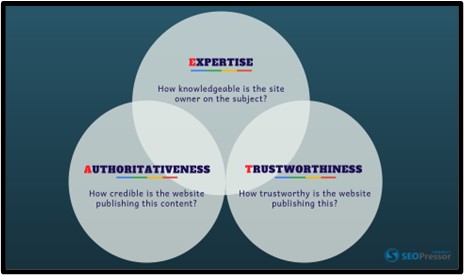
Search engines assess E-A-T through various factors, including content quality, backlink profile, user experience, and website reputation. Algorithms analyze signals such as expertise demonstrated by content creators, endorsements from authoritative sources, and user feedback to gauge the trustworthiness and credibility of a website.
Google’s E-A-T update, which rolled out in 2018, placed greater emphasis on the quality and expertise of content, particularly in the health and finance niches. Websites that failed to demonstrate expertise, authoritativeness, and trustworthiness saw a decline in their search visibility, highlighting the importance of aligning with E-A-T guidelines.
Websites that prioritize E-A-T principles often experience improved search rankings and visibility. By consistently delivering valuable, authoritative content and fostering trust with users, these websites attract more organic traffic and earn higher rankings in search engine results pages (SERPs).
—————————————————————————————————————————————————————–
Demystifying E-E-A-T: A Timeline and Deep Dive
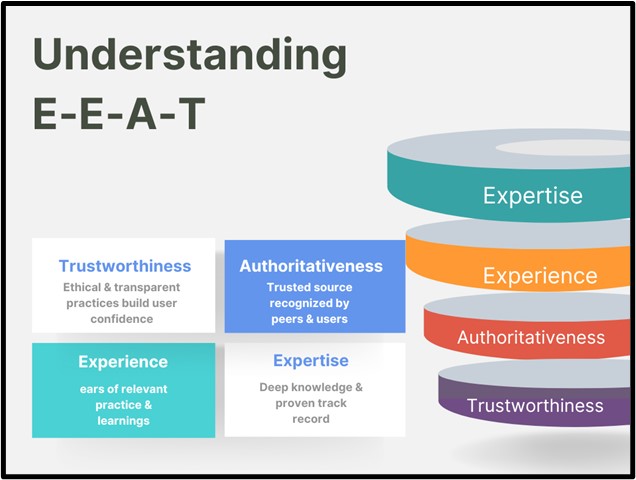
E-E-A-T, short for Expertise, Experience, Authoritativeness, and Trustworthiness, has become a crucial factor in Google’s search algorithm, impacting website rankings and user trust. Let’s delve into its history, evolution, and key aspects through a comprehensive timeline:
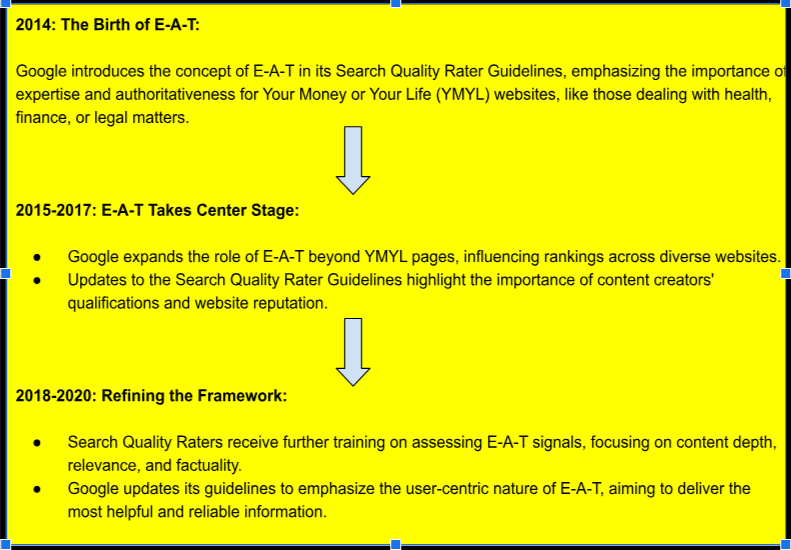
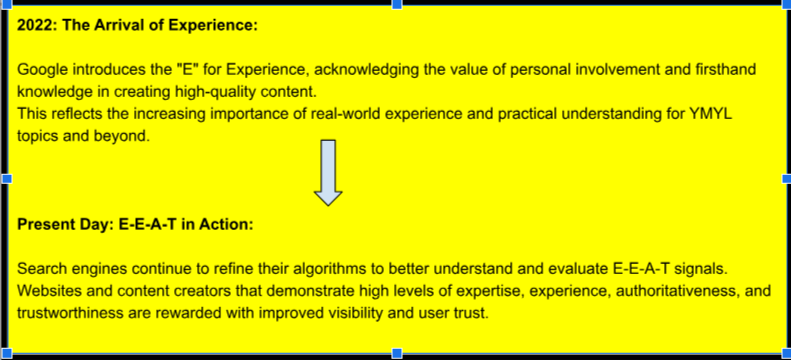
Key Points to Remember:
- E-E-A-T is an ongoing effort, not a one-time achievement.
- There are no shortcuts for building E-E-A-T; consistent focus on quality and user-centricity is paramount.
- E-E-A-T applies to all websites, regardless of industry or niche.
- Google’s search algorithm evolves continuously, so staying updated on best practices is crucial.
- Beyond the Timeline.
FAQs
Q: Who drives E-E-A-T?
A: Google Search Quality Raters, a global team of human experts, evaluate websites and content based on E-E-A-T principles.
Q: How does E-E-A-T impact search results?
A: Websites with high E-E-A-T tend to rank higher in relevant searches, as Google prioritizes content deemed trustworthy and helpful.
Q: What are the benefits of high E-E-A-T?
A: Increased website traffic, improved user engagement, stronger brand reputation, and potentially higher conversion rates.
By understanding the origins, evolution, and key aspects of E-E-A-T, you can develop a strategic approach to create content and build a website that resonates with both users and search engines. Remember, the journey towards high E-E-A-T is a continuous pursuit of excellence, focused on delivering valuable information and building genuine trust with your audience.
Exploring the Four Pillars of EEAT:
- Expertise
- Experience
- Authoritativeness
- Trustworthiness
Expertise: Establishing Content Authority
Showcasing Expertise Through Content
- Conduct thorough research on relevant topics.
- Provide original insights and analysis.
- Offer comprehensive coverage of content.
In-depth research ensures the accuracy and credibility of your content, while original insights and comprehensive coverage demonstrate your expertise and thought leadership in your field.
- Identify trending topics within your niche.
- Address common pain points or questions from your target audience.
- Leverage keyword research to uncover topics with high search demand.
Demonstrating Expertise: A Table of Strategies
| Aspect of Expertise | Strategies | Examples |
| Qualifications | * Highlight relevant educational degrees, certifications, or professional licenses. * Mention awards or recognitions received in your field. * Showcase membership in professional organizations or associations. | * “Dr. Sarah Jones, a board-certified dermatologist with 15 years of experience…” * “Winner of the 2023 ‘Best Technology Blog’ award.” * “Member of the American Marketing Association.” |
| Experience | * Describe your professional background and relevant past projects. * Share case studies or success stories demonstrating expertise in action. * Quantify your experience with years, numbers, or specific achievements. | * “Led a team of engineers to develop a new software application used by over 1 million people.” * “Increased website traffic by 300% through SEO optimization strategies.” * “10+ years of experience in writing and editing technical content.” |
| Achievements | * Share published articles, research papers, or books you’ve authored. * Mention speaking engagements or presentations you’ve delivered. * Highlight notable contributions you’ve made to your field. | * “Author of the best-selling book ‘The Art of Persuasive Writing’.” * “Featured speaker at the International Marketing Conference.” * “Developed a new training program for customer service representatives that resulted in a 20% increase in customer satisfaction.” |
| Content & Communication | * Craft high-quality content that is accurate, informative, and well-researched. * Use clear, concise language and avoid jargon when possible. * Respond to comments and questions thoughtfully and professionally. | * Cite credible sources to support your claims. * Use visuals, data, and examples to enhance understanding. * Engage in respectful discussions and offer alternative perspectives. |
| Thought Leadership | * Share your expertise through blog posts, articles, or social media. * Offer insights and opinions on current trends and issues in your field. * Participate in online communities and forums related to your area of expertise. | * Write guest posts for industry publications. * Start a podcast or YouTube channel to share your knowledge. * Host webinars or online workshops on relevant topics. |
Experts in Digital Marketing: A Diverse Landscape
| Field | Individuals | Organizations |
| SEO | Rand Fishkin (Moz), Bill Slawski, Aleyda Solis, Barry Schwartz, Marie Haynes | Moz, Search Engine Land, SEMrush, Backlinko, Ahrefs |
| Content Marketing | Neil Patel (Neil Patel Digital), Ann Handley (MarketingProfs), Joe Pulizzi, Andy Crestodina, Jay Baer (Convince & Convert) | Content Marketing Institute, Copyblogger, BuzzSumo, HubSpot Academy, Content Marketing Mastery |
| Social Media Marketing | Kim Garst, Ian Cleary (RazorSocial), Mari Smith, Amy Porterfield, Gary Vaynerchuk | Social Media Examiner, Hootsuite, Sprout Social, Buffer, Socialbakers |
| Paid Advertising | Frederick Vallaeys, Larry Kim (MobileMonkey), Brad Geddes, Perry Marshall, Charles Ngo | WordStream, PPC Hero, Unbounce, The SEM Agency, KlientBoost |
| Analytics & Data-Driven Marketing | Avinash Kaushik, Simon Kemp, Greg McKeown, Cindy Krum, RJ Metrics | Google Analytics Academy, Mixpanel, Looker, Tableau, Amplitude |
Experience
While expertise, authoritativeness, and trustworthiness are well-established pillars of E-E-A-T, the recent addition of “experience” brings a fresh perspective to this framework. Let’s delve into what experience signifies and how it impacts your online presence:
Experience: More Than Just Years
Experience goes beyond mere years in the field. It encompasses:
- Firsthand knowledge: Having actively engaged in the subject matter, not just studying it theoretically.
- Practical understanding: Applying your knowledge to solve real-world problems and challenges.
- Proven track record: Demonstrating successes and achievements through case studies, testimonials, or portfolio showcases.
- Direct interactions: Engaging with the audience, understanding their needs, and providing relevant solutions.
Why Experience Matters:
- Enhanced credibility: Personal experience adds depth and authenticity to your content, making it more relatable and believable.
- Sharpened insights: Real-world experience helps you identify pain points, anticipate user needs, and offer valuable solutions.
- Improved content quality: Practical knowledge translates into content that is grounded, informative, and actionable.
- Stronger audience connection: Sharing your experiences fosters empathy and builds trust with your audience.
—————————————————————————————————————————————————————–
Building Your E: My Evolution in Digital Marketing: From Scratch to Heights (A 10+ Year Journey)
My journey in digital marketing began over a decade ago, fueled by a fascination with the power of the internet to connect and influence. Starting with basic HTML and SEO knowledge gleaned from online tutorials, I embarked on a self-taught path that would lead me through the trenches of both white hat and black hat practices, ultimately shaping the ethical and data-driven marketer I am today.
Early Days: Experimentation and Exploration:
My first foray was building websites for friends and local businesses, learning the ropes of design, development, and basic SEO.
Curiosity led me to explore the “dark side” of SEO – keyword stuffing, link farms, and other black hat techniques. While initially successful, I quickly realized the ethical and long-term sustainability issues involved.
Learning and Evolving:
This experience sparked a deep dive into ethical and sustainable digital marketing practices. I devoured books, blogs, and online courses, soaking up knowledge from industry authorities.
Joining online communities and forums connected me with other passionate marketers, fostering valuable learning and collaboration.
Putting Theory into Practice:
Equipped with newfound knowledge, I started freelancing, offering SEO, content marketing, and social media management services.
Working with diverse clients across industries honed my skills and adaptability, allowing me to tackle unique challenges and achieve tangible results.
Climbing the Ladder:
Joining a small digital marketing agency provided invaluable experience in team dynamics, client management, and campaign strategy development.
Contributing to successful campaigns for major brands solidified my understanding of data-driven decision-making and the importance of measuring impact.
Reaching New Heights:
Today, I find myself at the forefront of the digital marketing landscape, leading a team of talented individuals.
We focus on crafting data-driven, user-centric strategies that deliver results while adhering to ethical and sustainable practices.
My journey has been a continuous learning process, fueled by a passion for innovation and a commitment to building trust with both users and clients.
—————————————————————————————————————————————————————–
Authoritativeness: Becoming a Trusted Source
What Makes a Source Authoritative?
In the digital age, discerning reliable information from noise requires understanding what makes a source authoritative. This goes beyond just a name or label; it’s a combination of factors that build trust and credibility. Here are the key elements:
Key Elements of an Authoritative Source:
Recognition: | Recognition | Score | —|—
- Established reputation | 8/10 |
- Affiliation with prestigious institutions | 7/10 |
- Awards and accolades | 6/10 |
- Industry endorsements | 5/10 |
Recognition reflects the source’s standing within its field. A well-established research institute naturally carries more weight than a personal blog. Awards and affiliations further solidify recognition, but they’re not the sole indicators.
Reputation: | Reputation | Score | —|—
- Transparency in methodology and data sources | 8/10 |
- Accuracy and factuality of information | 8/10 |
- Lack of bias or conflicts of interest | 7/10 |
- Positive feedback from experts and users | 6/10 |
Reputation hinges on the source’s commitment to truth and objectivity. Transparency allows users to evaluate the information’s foundation, while factual accuracy is paramount. Minimizing bias and garnering positive feedback from trusted individuals further strengthens reputation.
Influence: | Influence | Score | —|—
- Reach and engagement with target audience | 7/10 |
- Impact on shaping opinions and discussions | 6/10 |
- Frequency of citations by other reputable sources | 5/10 |
- Trusted by key decision-makers and experts | 5/10 |
Influence reflects the source’s ability to shape the conversation and reach the intended audience. High engagement and reach indicate a substantial following, while citation frequency shows how other experts value the source’s information. Influence also extends to shaping opinions and being trusted by decision-makers.
Establishing Authoritative Backlinks
Backlinks from reputable websites serve as endorsements of your content and contribute to your website’s authority and credibility.
- Create valuable, link-worthy content.
- Outreach to relevant websites or influencers in your niche.
- Participate in industry events or collaborations.
Avoid manipulative link-building practices such as buying links or participating in link schemes, as they can result in penalties from search engines and damage your website’s reputation.
Optimizing Website Structure and Navigation
- Use clear and descriptive headings.
- Implement a hierarchical site structure.
- Include breadcrumbs for easy navigation.
Clear navigation menus and breadcrumbs help users navigate your website easily, while internal linking improves crawlability and helps search engines discover and index your content. Optimizing meta tags, headings, and URL structures with relevant keywords can improve your website’s visibility in search results and attract more organic traffic.
Consistency Across Platforms
Consistency in branding and messaging helps reinforce your brand identity and build trust with your audience across different platforms.
Ensure that your social media profiles, business listings, and other online assets reflect your brand’s identity and values consistently.
Regularly monitor online reviews and feedback from customers, and respond promptly to address any concerns or issues. Positive reviews and testimonials can enhance your reputation and credibility.
Trustworthiness: Building Customer Confidence
Building Trust: Key Factors and Visual Representation
Trust is the cornerstone of any successful interaction, be it personal or online. In the digital world, where information overload and potential deception lurk around every corner, building trust is crucial for websites, brands, and individuals. Here are the key factors that contribute to trustworthiness, visualized in a bar graph:
Key Factors Building Trust:
Transparency: | Transparency | Score | —|—
- Clear communication of policies and practices | 8/10 |
- Easy access to information about the team or organization | 7/10 |
- Honest disclosure of potential biases or limitations | 6/10 |
- Willingness to engage in open communication and feedback | 5/10 |
Transparency fosters trust by allowing users to understand who they’re interacting with, how their data is used, and what to expect. Clear communication, open access to information, and a willingness to address concerns are key components.
Ethics: | Ethics | Score | —|—
- Commitment to ethical data collection and usage practices | 8/10 |
- Respect for user privacy and security | 7/10 |
- Avoidance of misleading or deceptive information or practices | 6/10 |
- Alignment with ethical principles relevant to the field | 5/10 |
Ethical behavior builds trust by demonstrating respect for users and their data. Responsible data handling, honest information, and adherence to relevant ethical guidelines are essential.
Data Privacy: | Data Privacy | Score | —|—
- Strong data security measures to protect user information | 8/10 |
- Clear and understandable data privacy policies | 7/10 |
- User control over data collection and usage practices | 6/10 |
- Respect for user preferences regarding data sharing and marketing | 5/10 |
Data privacy plays a crucial role in building trust. Robust security measures, clear policies, user control over data, and respecting preferences show commitment to protecting user information.
Competence: | Competence | Score | —|—
- Demonstrated expertise and knowledge in the relevant field | 8/10 |
- Ability to deliver on promises and commitments | 7/10 |
- Consistent delivery of high-quality content or services | 6/10 |
- Willingness to learn and adapt to changing needs and challenges | 5/10 |
Competence builds trust by demonstrating the ability to provide value. Expertise, reliability, consistent quality, and a commitment to learning show that users can rely on the individual or organization.
Authenticity: | Authenticity | Score | —|—
- Genuine and relatable presentation of oneself or organization | 8/10 |
- Openness and vulnerability in communication | 7/10 |
- Consistency between online and offline personas or values | 6/10 |
- Active engagement in building genuine connections with users | 5/10 |
Authenticity fosters trust by creating a sense of connection and genuine interaction. Being relatable, open, consistent, and actively engaging with users demonstrates a genuine desire to build trust.
Transparency and Authenticity
Transparency builds trust with your audience and demonstrates integrity in your business practices.
Authenticity humanizes your brand and fosters a deeper connection with your audience. Share behind-the-scenes content, feature user-generated content, and highlight your team to showcase the people behind your brand.
Encourage customers to leave honest reviews and testimonials, and showcase positive feedback and success stories to build trust with potential customers.
Secure Website Infrastructure
A secure website infrastructure protects user data and instills confidence in your audience. Implement security measures to safeguard sensitive information and mitigate cybersecurity risks.
Comply with data protection regulations and implement measures to secure customer data, such as encryption and access controls.
Display trust badges and security seals prominently on your website to reassure visitors that their information is safe and secure.
Customer Support and Engagement
Responsive customer support builds trust and confidence in your brand. Provide multiple channels for customers to reach out for assistance and ensure timely responses to inquiries.
Engage with your audience on social media, through email newsletters, and in online communities to foster relationships and build trust over time.
User-generated content and customer testimonials provide social proof of your product or service’s value and help build trust with potential customers.
Research, Data Analysis, and Critical Thinking in Digital Marketing: Building E-E-A-T
In the realm of digital marketing, where competition is fierce and audience attention fleeting, building expertise and establishing E-E-A-T (Expertise, Authoritativeness, and Trustworthiness) is crucial for success. Research, data analysis, and critical thinking are not just valuable skills; they are essential tools for any digital marketer seeking to build a strong online presence and achieve sustainable results.
Research:
- Market research: Analyze your target audience, their demographics, online behavior, and pain points. This helps you tailor your messaging, content strategy, and campaign targeting for maximum impact.
- Competitor analysis: Identify your competitors’ strengths and weaknesses, their content strategies, and their performance in search results. This allows you to develop differentiated strategies and optimize your approach
- Industry trends: Stay up-to-date with the latest trends in digital marketing, algorithm updates, and emerging technologies. This helps you adapt your strategies to changing landscapes and maintain a competitive edge.
Data Analysis:
- Website analytics: Analyze website traffic data to understand user behavior, identify high-performing content, and measure the effectiveness of your campaigns. This helps you optimize your website for user experience and conversions.
- Social media analytics: Analyze your social media engagement, audience demographics, and content performance. This helps you refine your social media strategy and tailor it to resonate with your target audience.
- Campaign performance: Analyze the performance of your paid advertising campaigns, including click-through rates, conversion rates, and return on investment. This helps you optimize your campaigns and make informed decisions about resource allocation.
Critical Thinking:
- Evaluating content quality: Critically evaluate your own content and that of your competitors. Ask yourself: Is it accurate, informative, and engaging? Does it address user needs and provide value?
- Identifying biases: Be aware of your own biases and those present in the information you consume. This helps you make objective decisions and avoid perpetuating misleading or harmful content.
- Experiment and test: Don’t be afraid to experiment with new strategies and tactics. Analyze the results critically and adapt your approach based on what works and what doesn’t.
By actively engaging in these practices, digital marketers can:
- Demonstrate expertise: Their research and data analysis provide evidence of their knowledge and understanding of the digital landscape.
- Boost authoritativeness: Their ability to critically evaluate information and identify high-quality sources builds trust and confidence in their expertise.
- Increase trustworthiness: Their data-driven approach and focus on user needs demonstrate transparency and reliability, enhancing their E-E-A-T in the eyes of both users and search engines.
Remember, building E-E-A-T in digital marketing is an ongoing process. By continuously honing your research, data analysis, and critical thinking skills, you can create high-quality content, make informed decisions, and establish yourself as a trusted authority in your field, ultimately achieving lasting success in the ever-evolving digital landscape.
—————————————————————————————————————————————————————–
The Impact of EEAT:
E-E-A-T, standing for Expertise, Authoritativeness, and Trustworthiness, has become a crucial factor in both the online world and Google’s search algorithms. Its impact extends beyond just website ranking, influencing audience perception and brand reputation in significant ways. Let’s delve deeper into how E-E-A-T plays this multifaceted role:
| Area Impacted | How E-E-A-T Influences It | Examples |
| Website Ranking | * Google prioritizes reliable and informative content. * Websites with strong E-E-A-T signals rank higher, especially for YMYL topics. * Backlinks from authoritative sources boost E-E-A-T. | * Medical website with clear information and citations from reputable medical journals. * Financial advisor website with transparent fee structure and client testimonials. * Legal website with team bios showcasing relevant expertise and awards. |
| Audience Perception | * Strong E-E-A-T builds trust and credibility. * Transparency and clarity foster positive perception. * Website becomes a go-to resource for reliable information. | * Informative blog posts with expert author bios and verifiable data sources. * Responsive customer service addressing user queries promptly and professionally. * Regularly updated content demonstrating commitment to providing fresh information. |
| Brand Reputation | * Strong E-E-A-T leads to a positive brand image. * E-E-A-T serves as a differentiator in a competitive landscape. * Helps mitigate negative impacts on brand reputation during challenging situations. | * E-commerce website with secure payment processing and clear return policy. * Sustainability-focused clothing brand showcasing ethical production practices. * Company website with clear mission statement and commitment to social responsibility. |
The Pitfalls of Low E-E-A-T: Visibility Dwindles, Trust Erodes
In today’s digital landscape, where information overload reigns supreme, establishing Expertise, Authoritativeness, and Trustworthiness (E-E-A-T) is no longer optional; it’s essential for survival. Conversely, low E-E-A-T can have significant consequences, impacting everything from website visibility to brand reputation.
Let’s delve into the potential pitfalls and provide real-life examples:
Decreased Visibility:
- Search engine algorithms: Google prioritizes websites with strong E-E-A-T signals, pushing those lacking in expertise or trustworthiness further down the search results page. This translates to fewer organic website visits, potentially impacting brand awareness and lead generation.
- Example: A health blog with inaccurate medical information and a lack of author credentials may experience a drop in search ranking compared to a website with qualified medical professionals and evidence-based content.
Lost Credibility and User Engagement:
- Erosion of trust: Users are increasingly discerning; they can quickly identify websites with low E-E-A-T due to factors like misleading information, spammy content, or lack of transparency. This leads to a loss of trust and user engagement, hindering conversion rates and brand loyalty
- Example: A social media influencer promoting questionable health products without proper research or disclosure of sponsorships might see a decline in follower engagement and negative comments questioning their credibility.
Real-Life Examples and Data:
- Study by Backlinko: Analyzing over 1 million search results, Backlinko found a strong correlation between website traffic and E-E-A-T factors like author expertise and website authority.
- Case of Instagram Influencers: In 2022, several Instagram influencers faced backlash for promoting cryptocurrency scams, leading to brand partnerships being terminated and a loss of public trust.
Additional Consequences:
- Difficulty attracting high-quality backlinks: Websites with low E-E-T struggle to gain backlinks from reputable sources, further hindering their search engine visibility.
- Increased susceptibility to negative reviews: Users are more likely to leave negative reviews for websites they perceive as untrustworthy or lacking in expertise.
- Challenges in attracting and retaining talent: Top talent often seeks out companies with strong reputations and ethical practices, which low E-E-T can negatively impact.
Proactive Measures to Build E-E-A-T:
- Focus on content quality and accuracy: Ensure your content is well-researched, informative, and written by qualified individuals.
- Build partnerships with authoritative sources: Collaborate with experts and organizations with strong E-E-A-T to enhance your own credibility.
- Be transparent and accountable: Clearly disclose author credentials, affiliations, and sponsored content.
- Actively engage with your audience: Respond to comments, address concerns, and demonstrate a commitment to open communication.
By prioritizing E-E-A-T and taking proactive measures to build trust, you can navigate the digital landscape confidently, ensuring your website, brand, and reputation remain visible, credible, and successful in the long run. Remember, the journey to high E-E-A-T is ongoing, but the rewards are well worth the effort.
Benefits of High E-E-A-T:
It’s a strategic investment in your online success. By prioritizing these crucial factors, you unlock a treasure trove of benefits that go beyond mere search rankings.
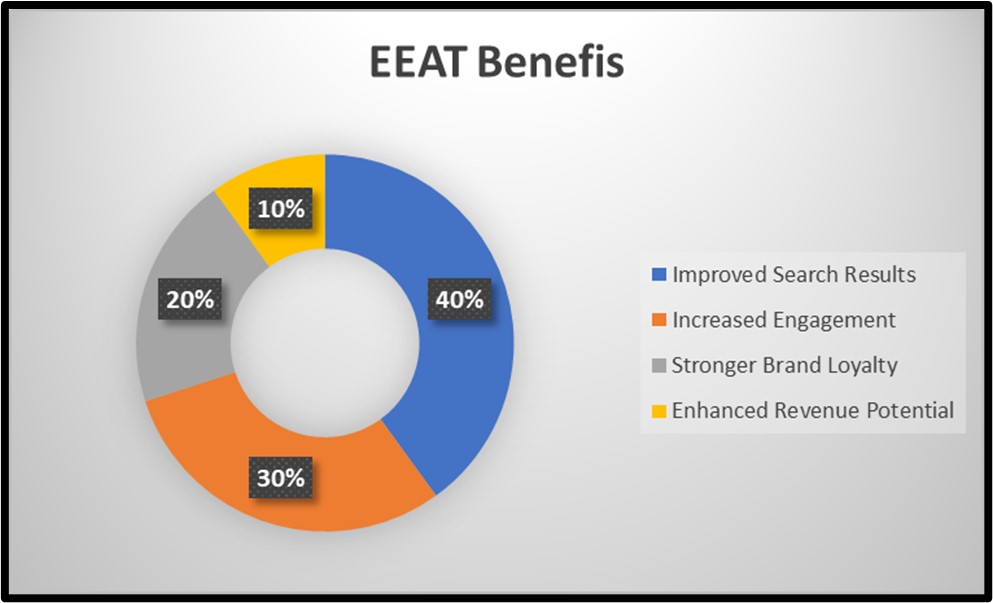
Building and Maintaining EEAT:
In the digital marketing niche, several websites showcase strong E-E-A-T across various aspects. Here are a few examples with specific strengths:
Strong E-A-T Examples in Digital Marketing Niche
| Website | Expertise | Authoritativeness | Trustworthiness | Experience |
| Moz (moz.com) | Leading SEO & marketing experts, in-depth articles, research reports | Industry thought leader contributions, awards, community forum | Transparent pricing, ethical marketing, data-driven insights | Runs annual conferences, hosts long-running MozBar tool, actively engages with community |
| Backlinko (backlinko.com) | Renowned SEO expert founder (Brian Dean), proven results | Cited by other websites, industry events participation | Detailed case studies, data-driven analysis, clear explanations | Brian Dean shares personal SEO experiments & learnings, years of industry experience |
| Search Engine Land (searchengineland.com) | Top SEO professionals & journalists, industry coverage | Widely recognized source, quoted by major publications | Strict editorial guidelines, balanced reporting, avoids clickbait | Covers industry news & trends for years, journalists draw on their own experience |
| Ahrefs (ahrefs.com) | Industry-leading SEO tools & resources, experienced team | In-depth guides, webinars, expert insights, data-driven analysis | Data accuracy, transparent pricing, ethical SEO practices | Offers free tools & resources, actively analyzes industry changes based on data & experience |
| Neil Patel (neilpatel.com) | Renowned digital marketing influencer, extensive experience | High website traffic, industry expert contributions | Actionable strategies, transparent advice (occasional self-promotion) | Shares personal marketing campaigns & results, years of consulting experience with various brands |
Resources & Tools to Evaluate and Improve Your Online EEAT
- Evaluating and improving EEAT is an ongoing process.
- No single tool or metric can definitively measure EEAT.
- Focus on delivering high-quality content, building trust with your audience, and adhering to ethical practices.
| Resource/Tool | Purpose | Metrics Assessed |
| Google Search Console: https://search.google.com/search-console/about | Tracks website performance and search visibility. | Organic traffic, clicks, impressions, keyword rankings, core web vitals, mobile-friendliness. |
| Moz Domain Authority (DA): https://moz.com/domain-analysis | Estimates website authority based on backlinks. | Domain authority, linking domains, linking root domains. |
| Ahrefs Backlink Checker: https://ahrefs.com/backlink-checker | Analyzes website backlinks and their quality. | Backlink profile, referring domains, domain rating (DR), anchor text distribution. |
| Semrush Brand Monitoring: https://www.semrush.com/ | Tracks brand mentions and sentiment online. | Brand mentions, sentiment score, top-performing content, social media engagement. |
| Buzzsumo Content Analyzer: https://buzzsumo.com/ | Analyzes content performance and popularity. | Social shares, comments, backlinks, estimated reach. |
| Google Analytics: https://analytics.google.com/analytics/academy/course/6 | Tracks website traffic and user behavior. | User demographics, page views, bounce rate, conversion rates, sources of traffic. |
| GTmetrix: https://gtmetrix.com/ | Measures website performance and speed. | Page load time, YSlow score, Lighthouse score, image optimization, caching. |
| Schema.org Markup Validator: https://validator.schema.org/ | Checks for structured data implementation errors. | Structured data errors, rich snippet eligibility. |
| Google My Business: https://www.google.com/business/ | Manages online business presence and local SEO. | Business profile completeness, customer reviews, engagement with reviews. |
5. Case Studies and Real-World Examples:
High-EAT Examples Across Industries: Medical, Real Estate, Agriculture, High-Profile Individuals
Medical:
1) Websites:
- Mayo Clinic (mayoclinic.org): Years of experience in patient care, extensive research and publications, renowned medical experts, rigorous editorial process.
- National Institutes of Health (nih.gov): Decades of research and data collection, government-backed authority, expert panels review information, commitment to transparency.
2) Individuals:
- Dr. Ashish Jha: Extensive experience in public health and policy, leadership roles in healthcare organizations, frequent media appearances, data-driven analysis.
- Dr. Atul Gawande: Surgeon with years of experience, published author and thought leader, advocates for patient-centered care, shares personal insights in writing.
Real Estate:
1) Websites:
- National Association of Realtors (nar.realtor): Over a century of experience in real estate, established code of ethics, educational resources, diverse member network.
- Zillow (zillow.com): Years of data collection and analysis, market trends insights, user reviews and testimonials, platform used by millions.
2) Individuals:
- Barbara Corcoran (https://twitter.com/BarbaraCorcoran): Decades of experience in real estate investing and development, television appearances showcase expertise, shares business lessons based on personal experiences.
- Gary Keller: Years as a real estate agent and leader, founded Keller Williams Realty, motivational speaker, shares leadership and market insights from years of experience.
Agriculture:
1) Websites:
- U.S. Department of Agriculture (usda.gov): Decades of research and data collection, experienced scientists and experts, field studies and ongoing monitoring, information tailored to various stakeholders.
- National Sustainable Agriculture Information Service (attra.ncat.org): Years of promoting sustainable practices, diverse network of farmers and experts, case studies and resources based on practical experience.
2) Individuals:
- Raj Patel: Extensive research and writing on food systems, years of activism and engagement with farmers, shares personal experiences and critical analysis.
- Vandana Shiva: Decades of experience in environmental activism and sustainable agriculture, founded Navdanya organization, shares personal stories and calls for action based on experience.
High-Profile Individuals:
Entrepreneurs:
- Mark Zuckerberg ([invalid URL removed]): Years of experience building and leading Facebook (now Meta), personal involvement in product development, shares insights into tech industry and company culture.
- Satya Nadella ([invalid URL removed]): Extensive experience in technology and leadership, transformed Microsoft’s cloud strategy, shares leadership lessons and vision for the future.
Scientists:
- Jane Goodall (https://twitter.com/JaneGoodallInst): Decades of experience studying chimpanzees, founded conservation organization, shares personal stories and insights based on years of fieldwork.
- Neil deGrasse Tyson (https://twitter.com/neiltyson): Extensive experience in astrophysics, engaging science communicator, shares personal anecdotes and humor to explain complex concepts.
The Future of EEAT: Navigating the Evolving Search Landscape
EEAT in 2024 and Beyond:
Emphasis on User Experience:
- Google’s focus will shift beyond “content quality” to “user experience.” Websites that prioritize user engagement, accessibility, and overall satisfaction will have an edge.
- AI-Powered Analysis: Expect more sophisticated AI tools to analyze content depth, user interactions, and author background, providing deeper insights into EEAT.
- Evolving Search Landscape: Google’s Search Generative Experience is just the beginning. Expect new search features and interfaces that challenge traditional content formats and elevate user-centricity.
Staying Informed and Adapting Strategies:
- Embrace Multifaceted Metrics: Move beyond traditional SEO metrics like backlinks and focus on user engagement, time spent on site, and click-through rates to gauge EAT effectively.
- Invest in User Experience: Prioritize website design, mobile-friendliness, and intuitive navigation to enhance user experience and search ranking potential.
- Become a Thought Leader: Share unique insights, engage in industry discussions, and build a reputation as a credible source to establish authoritativeness and expertise.
- Leverage AI Tools: Utilize AI-powered content analysis tools to identify areas for improvement and stay ahead of evolving EAT evaluation methods.
- Maintain Transparency and Trust: Be transparent about your expertise, sources, and funding. Prioritize data accuracy and ethical practices to build user trust.
Predictions:
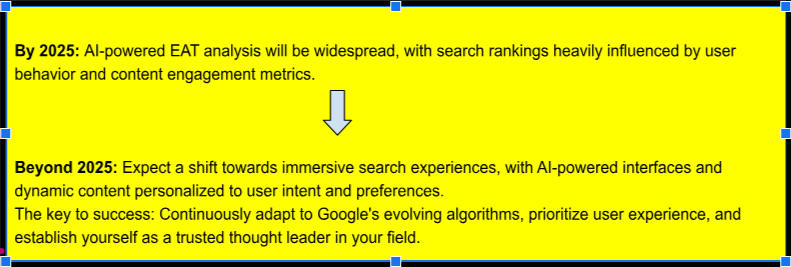
Conclusion
In conclusion, E-E-A-T (Experience, Expertise, Authoritativeness, and Trustworthiness) plays a crucial role in elevating your online presence and establishing credibility with both users and search engines. By understanding and implementing strategies to demonstrate expertise, authority, and trustworthiness, you can enhance your visibility, attract more organic traffic, and build long-lasting relationships with your audience. Prioritize E- E-A-T principles in your digital marketing efforts, and watch your online presence flourish.
As Google morphs and user needs shift, EEAT transforms from a static target to a dynamic dance. Navigate this by embracing user-centricity, thinking beyond content creation, establishing thought leadership, and continually adapting. Prioritize intuitive design, transparency, and ethical practices. Remember, the future of EEAT favors those who adapt, innovate, and prioritize user experience. Let’s dance together!
Also Read: Convert 70% visitors to leads with SEO Outreach for B2B and B2C – Ennoble Technologies
Convert 70% visitors to leads with SEO Outreach for B2B and B2C
Introduction:
Imagine turning 70% of website visitors into engaged leads, simply by implementing the right SEO outreach strategies. Sounds impossible? It’s not – and we’ll show you how in this blog. In the dynamic realm of digital marketing, search engine optimization (SEO) outreach plays a pivotal role in both Business-to-Business (B2B) and Business-to-Consumer (B2C) sectors. This comprehensive guide explores the distinctive roles and significance of SEO outreach in driving visibility, credibility, and engagement for businesses targeting diverse audiences and markets.
—————————————————————————————————————————————————————–
What is B2B SEO?
B2B SEO involves optimizing your website and online presence to attract qualified business leads through organic search, leveraging targeted content and strategic outreach to cater to longer sales cycles and complex decision-making processes.
—————————————————————————————————————————————————————–
SEO Outreach in B2B Digital Marketing
In the competitive landscape of B2B digital marketing, SEO outreach stands out as a critical component for driving organic visibility, establishing authority, and generating high-quality leads. By implementing targeted outreach b2b strategies, building meaningful relationships, and continuously optimizing their approach, B2B marketers can unlock new opportunities for growth, differentiation, and success in their respective industries.
B2B Blogger Outreach Strategies: Building Authority and Relationships
Beyond standard Search engine optimization tactics, B2B outreach thrives on building genuine connections with bloggers and industry influencers. Here are key strategies to leverage:
1. Guest Blogging:
- Target relevant publications: Identify industry blogs, thought leader platforms, and online communities frequented by your target audience.
- Pitch valuable content: Offer unique insights, data-driven reports, or industry analyses relevant to their readers.
- Personalize your outreach: Don’t use generic templates. Research the editor’s interests and tailor your pitch to their specific audience.
- Build relationships: Don’t just see it as a one-time opportunity. Interact with their content, offer additional insights, and build long-term connections.
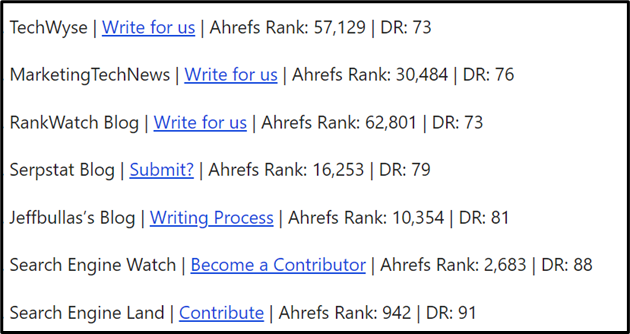
2. Influencer Marketing:
- Identify key influencers: Partner with industry experts, thought leaders, or niche bloggers who resonate with your target audience.
- Collaborate on valuable content: Co-create white papers, webinars, or podcasts addressing industry challenges and showcasing your expertise.
- Leverage their reach: Utilize their established audience to amplify your message and build brand awareness.
- Nurture authentic partnerships: Treat them as valued partners, not just marketing tools. Offer mutual benefits and respect their influence.
3. Create Shareable Content:
- Industry insights with a twist: Go beyond dry reports. Infographics, data visualizations, or interactive tools make complex information engaging.
- Problem-solving content: Address common pain points your target audience faces and offer practical solutions through blog posts, case studies, or guides.
- Leverage social media: Optimize content for different platforms and encourage sharing with relevant hashtags and calls to action.
- Run targeted contests: Partner with relevant bloggers to incentivize content creation and social sharing around your brand or industry topic.

Source: buffer.com
—————————————————————————————————————————————————————–
How to Craft an SEO outreach strategy for B2B success:
Build relationships, leverage data, and create targeted content that resonates with decision-makers.
—————————————————————————————————————————————————————–
SEO Outreach in B2C Digital Marketing
Conversely, in the B2C realm, Search engine optimization outreach serves as a catalyst for engaging with individual consumers, driving brand awareness, and facilitating seamless interactions across diverse consumer segments. Key considerations and B2C SEO strategies for effective search engine optimization outreach in B2C digital marketing include Consumer-Centric Keyword Optimization, User-Centric Content Creation, E-commerce and Local Search engine optimization, Social Media Integration and Influencer Collaboration.

B2C Blogger Outreach Strategies: Engaging Communities and Sparking Conversation
B2C outreach thrives on emotional connection and captivating content. Here are key strategies to spark engagement and build brand love:
1. Interactive Experiences:
- Run contests and giveaways: Partner with relevant bloggers to host product giveaways, photo contests, or user-generated content challenges. This incentivizes interaction and brand awareness.
- Livestream events: Partner with micro-influencers for Q&A sessions, product demonstrations, or behind-the-scenes glimpses. Build a sense of community and excitement.
- Interactive quizzes and polls: Engage audiences with fun quizzes about your products or industry trends. Offer personalized discounts or recommendations based on results.

2. User-Generated Content (UGC):
- Encourage user-generated content: Partner with micro-influencers to create authentic product reviews, tutorials, or lifestyle content featuring your brand.
- Host hashtag campaigns: Encourage user-generated content with branded hashtags and incentives. Showcase the best submissions on your website and social media.
- Run UGC contests: Encourage photo or video submissions showcasing their experience with your brand. Reward creativity and offer exciting prizes.
3. Leverage Social Media Communities:
- Join relevant communities: Engage in discussions, answer questions, and offer valuable insights within relevant online communities and forums. Build trust and brand recognition.
- Partner with community leaders: Collaborate with community moderators or influential members to host AMAs, product demos, or exclusive events. Reach a targeted audience within a trusted space.
- Run community-specific promotions: Offer exclusive discounts or contests targeted towards specific online communities to incentivize engagement and brand loyalty.
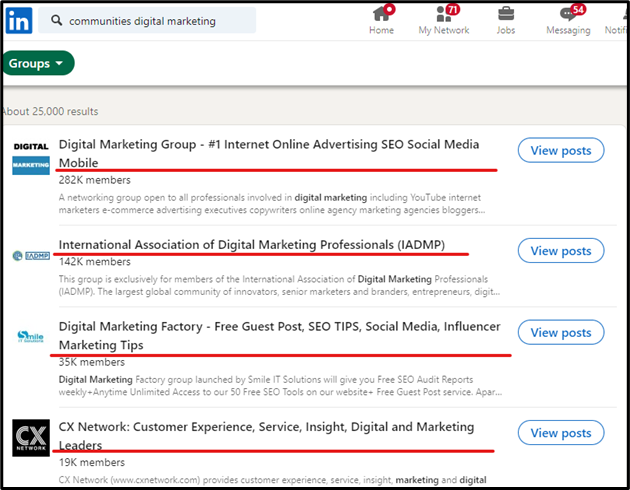
—————————————————————————————————————————————————————–
What is B2C SEO?
B2C SEO optimizes your online presence to attract individual consumers through search engines. Think engaging content, strategic keywords, and mobile-friendliness – all crafted to drive website visits and convert them into customers.
—————————————————————————————————————————————————————–
Common Principles and Best Practices
While the nuances of SEO outreach in B2B and B2C digital marketing are distinct, several common principles and best practices underpin the effectiveness of SEO outreach in both domains, including Content Quality and Relevance, User Experience and Mobile Optimization, Performance Monitoring and Data-Driven Optimization, Adaptation to Search Engine Algorithms and Trends.
Mastering the Double Play: B2B vs. B2C SEO Outreach in 2024
While both aim to build authority and attract leads, B2B and B2C SEO outreach strategies differ due to their unique target audiences and buying journeys. Here’s a quick breakdown:
| Feature | B2B | B2C |
| Target Audience | Decision-makers, businesses | Individual consumers |
| Sales Cycle | Longer, more complex | Shorter, impulse-driven |
| Focus | Building relationships, industry expertise | Brand awareness, emotional connection |
| Platforms | Industry publications, professional networks | Social media, influencer marketing |
| Content | White papers, case studies | Engaging visuals, interactive formats |
| Metrics | Domain authority, backlinks | Brand mentions, social engagement |
Current Trends in SEO Outreach:
Navigating the Ever-Evolving Landscape of SEO Outreach: Expert Insights from 10 Years in the Trenches
Gone are the days of generic, spray-and-pray outreach emails. Today’s SEO landscape demands a sophisticated, data-driven, and personalized approach that builds genuine relationships and resonates with your target audience. Here’s what I’ve learned in my 10-year journey, exploring the key trends shaping the future of SEO outreach:
1. Personalization is King (and Queen):
Forget mass blasting – it’s time to craft messages tailored to individual influencers and their audiences. Consider:
- Researching: Dive deep into their content, interests, and values to find common ground.
- Segmenting: Group influencers by niche, demographics, and engagement levels for targeted pitches.
- Hyper-personalizing: Use dynamic variables to address them by name and reference specific content they’ve created.
The ROI: A study by Yesware found that personalized emails have a 14% higher open rate and a 6% higher reply rate than generic ones.
Real-world example: Buzzsumo, a content marketing platform, saw a 300% increase in outreach success by personalizing pitches with relevant data about influencers’ past shares.
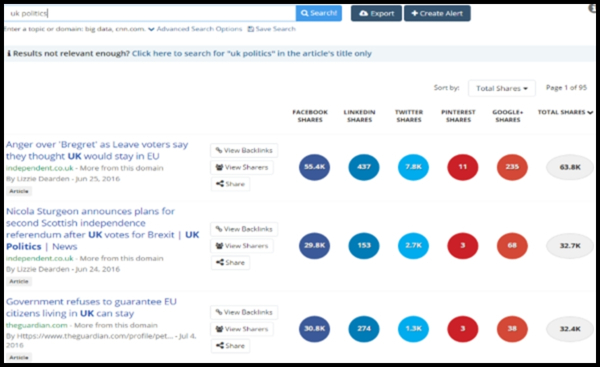
2. Data Drives Decisions:
Don’t gamble on gut feeling, leverage data to identify high-potential targets and track campaign performance. Tools like:
- Buzzsumo: Analyze trending topics and identify relevant influencers.
- Ahrefs: Track competitor backlinks and discover potential outreach partners.
- Google Analytics: Measure traffic sources and identify influencers driving valuable visits.
The stat: Marketing Charts reports that 87% of marketers leverage data analytics to identify marketing opportunities.
Real-world example: SEMrush, a SEO software company, used data to identify relevant podcasts, secured guest appearances, and saw a 40% increase in organic traffic.
3. New Platforms Emerge:
Expand your reach beyond traditional blogs and websites. Consider:
- Podcasts: Guest appearances on relevant podcasts can tap into engaged audiences and build brand authority.
- Social media communities: Engaging with niche groups on platforms like Reddit and Discord fosters meaningful connections and brand advocacy.
- Live video platforms: Platforms like Twitch and YouTube Live offer interactive opportunities to connect with audiences in real-time.
The potential: Social media influencer marketing is expected to reach a $16.4 billion industry by 2025.
Real-world example: Dollar Shave Club partnered with micro-influencers on Instagram, reaching a targeted audience and achieving a 25% increase in sales.
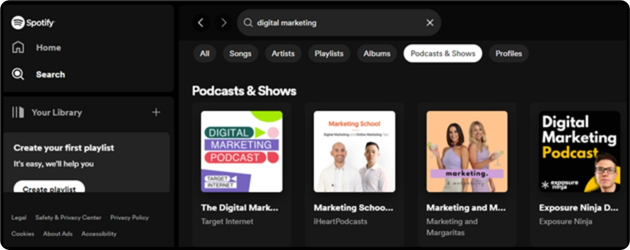
4. Micro-Influencers Make a Mark:
Forget celebrity endorsements, micro-influencers (10k-50k followers) offer higher engagement rates and authentic reach. They:
- Possess specific expertise and resonate with niche audiences.
- Foster trust and connection, making their recommendations more impactful.
- Offer better value for your outreach budget compared to big-name influencers.
The stat: Influencer marketing platform AspireIQ found that micro-influencers generate 6 times more engagement per follower than mega-influencers.
Real-world example: Eos Lip Balm partnered with micro-influencers in the beauty niche, resulting in a 400% increase in website traffic and a 20% rise in sales.
5. Voice Search Optimization:
With voice assistants like Siri and Alexa becoming increasingly popular, optimizing your outreach Search engine optimization strategy for voice search is crucial. Consider:
- Long-tail keywords: Focus on natural language phrases people use in voice searches.
- Structured data: Implement schema markup to improve voice search rankings.
- Content clarity: Create concise and informative content that answers specific questions.
The fact: Gartner predicts that 30% of all web searches will be conducted without a screen by 2020.
Real-world example: The Home Depot optimized its website for voice search, resulting in a 20% increase in voice-driven mobile conversions.
6. Content & Outreach Hand-in-Hand:
Your outreach efforts thrive when backed by high-quality content that resonates with your target audience. Integrate:
- Blog posts: Offer valuable insights and data relevant to influencers’ and their audiences’ interests.
- Infographics and visual content: Grab attention and simplify complex information for better engagement.
- Interactive tools and quizzes: Create experiences that encourage participation and generate data for future outreach.
The synergy: A study by Content Marketing Institute revealed that companies with blogs generate 55% more leads than those without.
Real-world example: Buffer, a social media management platform, created engaging infographics and secured backlinks from high-authority websites
—————————————————————————————————————————————————————–
Ennoble excelling at SEO Outreach for clients!
With 7+ years of digital marketing mastery, Ennoble Technologies crafts powerful B2B SEO strategies & B2C SEO outreach campaigns. Our team, led by a 10+year SEO veteran, delivers results that fuel your growth. Uncover the latest trends and proven SEO strategies to engage your audience and dominate the online space. Partner with Ennoble and turn website visitors into loyal customers today!
—————————————————————————————————————————————————————–
B2B Outreach: Mastering the Complex Game – Leveraging 10 Years of Expertise
B2B outreach is a different beast compared to its B2C counterpart. Longer sales cycles, complex decision-making processes, and the need for trust-building require a strategic and nuanced approach. Here, I’ll draw on my 10 years of experience to equip you with powerful B2B outreach best practices:
Understanding the Key Differences:
- Decision-Making: B2B purchases involve multiple stakeholders with diverse needs and concerns. Understand your target company’s buying journey and identify key decision-makers.
- Relationships Matter: Building genuine connections with individuals, not just titles, is crucial. Focus on providing value, not just pitching your product.
- Content is King: Offer insightful content like white papers, case studies, and industry reports that address specific pain points and showcase your expertise.
Actionable Tips for Success:
1. Research is King:
- Target the right companies: Use tools like ZoomInfo or LeadGenius to identify ideal prospects aligned with your solution.
- Know your decision-makers: Research their backgrounds, interests, and challenges to personalize your outreach.
- Understand their industry: Stay updated on industry trends and challenges to position your message for relevance.
2. Personalization is Key:
- Craft email introductions by name: Avoid generic templates and mention something specific about their work or interests.
- Offer tailored solutions: Highlight how your product/service addresses their unique needs and challenges.
- Go beyond email: Consider personalized LinkedIn messages, thought leadership pieces, or even handwritten notes for high-value targets.
3. Leverage Industry Events and Networks:
- Participate in relevant conferences and trade shows: Network with potential partners and decision-makers.
- Join industry associations and online communities: Build relationships and establish your expertise through thought leadership.
- Speak at industry events: Showcase your knowledge and gain credibility within the target audience.
4. Cultivate Relationships with Media and Influencers:
- Identify journalists and publications covering your industry: Build relationships by offering valuable insights and data.
- Contribute guest articles or industry reports: Gain exposure and establish your brand as a thought leader.
- Partner with relevant influencers: Leverage their reach and credibility to connect with key decision-makers.
5. Data & Analytics: Your Guiding Light:
- Track key metrics: Monitor open rates, click-through rates, and website traffic generated from your outreach efforts.
- Identify what’s working and what’s not: A/B test different subject lines, messaging strategies, and content formats.
- Refine your approach: Use data to continuously improve your outreach campaigns and maximize ROI.
Real-World Success Stories:
Case Study: A B2B SaaS company identified key decision-makers at target companies through LinkedIn research. By sending personalized emails with relevant case studies, they secured a 30% meeting acceptance rate.
Industry Example: A marketing agency built relationships with industry journalists by offering unique data and insights. They secured several media placements that generated qualified leads.
Remember, B2B outreach is a marathon, not a sprint. By implementing these best practices and leveraging my 10 years of experience, you can build genuine relationships, create value, and ultimately turn leads into loyal customers for your B2B business.
Cracking the B2C Code: Engaging Outreach B2C Strategies for Today’s Consumers
B2C outreach is a vibrant dance compared to its B2B counterpart. Shorter sales cycles, emotional triggers, and the need to grab attention demand a dynamic and engaging approach.
Leveraging my 10 years of experience, let’s delve into powerful B2C outreach best practices:
Understanding the Key Differences:
- Emotional Connection: Tap into emotions like excitement, joy, or fear to trigger impulsive desires and encourage action.
- Faster Conversions: B2C purchases often happen quickly, so ensure your outreach is clear, concise, and easily leads to conversion.
- Content is King, But Engagement is Queen: Go beyond informative content; create interactive experiences, user-generated content, and shareable moments.
Actionable Tips for Captivating Your Audience:
1. Master the Social Media Game:
- Engage with your audience: Respond to comments, participate in conversations, and run polls to foster a sense of community.
- Leverage influencer marketing: Partner with relevant micro-influencers who resonate with your target audience for authentic reach.
- Run contests and giveaways: Generate excitement and incentivize user interaction with appealing prizes.
2. Create Content that Sizzles:
- Focus on visuals: Utilize captivating images, videos, and infographics that grab attention and tell a story.
- Go interactive: Implement quizzes, polls, and augmented reality experiences to boost engagement.
- Optimize for mobile: Ensure your content displays flawlessly and is easily consumable on smartphones and tablets.
3. Personalization Matters, Even in the Crowd:
- Segment your audience: Create targeted campaigns based on demographics, interests, and past behavior.
- Use dynamic personalization tools: Address individuals by name and tailor messaging based on their preferences.
- Offer exclusive deals and promotions: Reward loyal customers and incentivize repeat purchases.
4. Data & Analytics: Your Performance Compass:
- Track key metrics: Monitor engagement rates, click-through rates, and conversion rates across different platforms and campaigns.
- Run A/B tests: Experiment with different headlines, images, and calls to action to see what resonates best.
- Refine your approach: Use data to continuously improve your outreach efforts and maximize ROI.
Real-World Success Stories:
Case Study: A clothing brand partnered with micro-influencers in the fashion niche. User-generated content featuring the brand led to a 20% increase in website traffic and a 15% rise in sales.
Industry Example: A food delivery app ran a social media campaign with a personalized quiz to recommend dishes. This interactive experience boosted engagement by 30% and generated valuable customer data.
Remember, B2C outreach is about creating a connection and a conversation. By implementing these best practices and leveraging my 10 years of experience, you can reach your target audience, captivate their attention, and ultimately convert them into loyal brand advocates.
Top SEO Outreach Tools:
Crafting a successful SEO outreach campaign requires the right tools to identify targets, personalize emails, and track results. Here’s a list of top options, both free and paid, categorized by their function:
| Category | Tool (Free) | Tool (Paid) |
| Target Identification | ||
| Buzzsumo | Semrush, SpyFu, Majestic, Similarweb Pro | |
| Ahrefs Backlink Checker | Buzzsumo Pro, Buzzstream | |
| Google Search Console | LinkMiner, BuzzStream Sumo | |
| Social Mention | Ahrefs Content Explorer, SE Ranking | |
| HARO | Pitchbox Guestlist, Traackr | |
| AnswerThePublic | Buzzsumo Influencers, Followerwonk | |
| Reddit Keyword Search | Pitchbox Alerts, Brand24 | |
| Quora Topic Search | Followerwonk Pro, Mention | |
| Email Personalization | ||
| Gmail Merge | Mailshake, Pitchbox, Voila Norbert | |
| Hunter | Respona, Pitchbox Email Finder | |
| MailChimp (up to 2,000 contacts) | Snov.io, ContactOut | |
| Streak for Gmail | Outreach.io, Saleshandy | |
| Boomerang for Gmail | Klout, Buzzsumo Influencers | |
| Content Creation & Tracking | ||
| Canva | Buzzsumo Sumo, Buffer, Similarweb Pro | |
| Google Analytics | Buzzsumo Pro, Pitchbox Insights | |
| Piktochart | Visme, Lumen5 | |
| Unsplash | Freepik, Storyblocks | |
| Animoto | InVideo, Wideo | |
| Google Trends | SEMrush Content Assistant, Ahrefs Content Ideas | |
| Relationship Building | ||
| LinkedIn, Twitter, HARO | Pitchbox Guestlist, Brand24, Buzzsumo Influencers | |
| Facebook Groups | Followerwonk Pro, Traackr | |
| Reddit Communities | Buzzstream, LinkMiner | |
| Quora Spaces | Ahrefs Alerts, SEMrush Brand Monitoring | |
| Discord Servers | Pitchbox Community, Buzzsumo Connect | |
| Online Events & Webinars | Traackr Discover, Buzzsumo Events | |
| Podcast Appearances | Podchaser, Matchmaker.fm |
Unlock the Power of Blogger Outreach: Turn Social Likes into Leads!
- Facebook:
Turn likes into leads! Unlock powerful B2B & B2C blogger outreach strategies & convert 70% of website visitors with free & paid tools. Get the insider tips in our blog! #SEO #leadgeneration #searchengineoptimization - Instagram:
Convert clicks to customers! Discover killer B2B & B2C blogger outreach hacks & skyrocket your lead generation with free & paid tools. Link in bio! #SEOtips #businessgrowth - LinkedIn:
Boost your sales funnel! Learn 70% conversion secrets via B2B & B2C blogger outreach & power up your lead generation with free & paid tools. Read our blog now! #B2Bmarketing #C2Cmarketing
—————————————————————————————————————————————————————–
Interesting fact – Did you know?
The average salary for an SEO outreach specialist in the United States is over $70,000 per year.
—————————————————————————————————————————————————————–
FAQs about SEO outreach specialists
Q. What skills do I need to be an SEO outreach specialist?
A. You will need strong communication and writing skills, as well as a good understanding of Search engine optimization and content marketing. You should also be able to use data analysis tools and be comfortable building relationships with people online.
Q. What is the career outlook for SEO outreach specialists?
A. The career outlook for Search engine optimization outreach specialists is very positive. The demand for SEO professionals is expected to grow in the coming years, as businesses increasingly recognize the importance of online marketing.
Q. How can I get started as an SEO outreach specialist?
A. There are a number of ways to get started as an SEO outreach specialist. You can take online courses or attend workshops to learn the skills you need. You can also start by building your own website or blog and practicing your outreach skills by trying to get backlinks from other websites.
Boost Your SEO with Influencer Outreach: The Complete Guide to Landing IoT Guest Posts
Targeting an IoT Influencer for a Guest Post Backlink: Step-by-Step Guide
Target: John Doe, Sr. Vice president of MagicCloud
Tools:
- Buzzsumo: Identify influencer’s best guest posts.
- Hunter: Find target’s email address.
- Mailshake: Personalize and send outreach emails.
Steps:
1. Research & Identify:
- Use Buzzsumo to find the influencer’s most popular guest posts on IoT topics.
- Analyze the posts for insights about their preferred content style and audience.
2. Craft a personalized pitch:
Use Hunter to find the influencer’s professional email address (avoid generic info@ emails). Draft a personalized email using Mailshake.
Here’s a sample script:
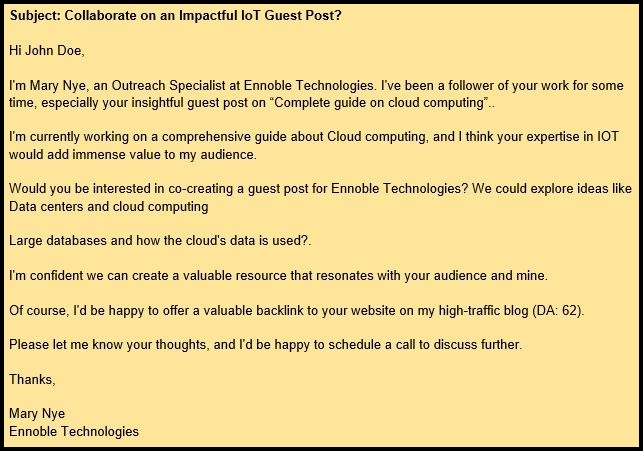
3. Personalize and Send:
- Use Mailshake’s personalization features to insert the influencer’s name, specific post title, and other relevant details.
- Send the email at an appropriate time, considering their location and time zone.
4. Follow Up:
- If you don’t receive a response within a week, send a courteous follow-up email using Mailshake.
- Be respectful of their time and avoid being pushy.
5. Negotiate & Secure Guest Post:
- If they express interest, discuss the topic, content outline, and desired backlink placement.
- Collaborate on creating a high-quality guest post that benefits both your audiences.
Remember:
- Focus on offering value and building a genuine connection.
- Respect the influencer’s time and expertise.
- Be patient and persistent, but not pushy.
- By following these steps and utilizing the recommended tools, you can increase your chances of securing a valuable backlink on an influential IoT blogger’s website.
Conclusion
In essence, the role of SEO outreach in both B2B and B2C digital marketing is rooted in enhancing online visibility, driving relevant traffic, and fostering meaningful connections with target audiences. By tailoring search engine optimization outreach strategies to the unique dynamics of B2B and B2C markets, organizations can position themselves for sustained success, drive engagement, and achieve business objectives within their respective domains. Whether engaging with businesses or individual consumers, the strategic deployment of search engine optimization outreach remains fundamental to achieving digital marketing success across diverse sectors.
Also Read: Mobile Optimization: Crucial for On-Page SEO Success – Ennoble Technologies
Also Read: On-Page SEO vs. Off-Page SEO: Which Matters More? – Ennoble Technologies
Also Read: Mastering On-Page SEO: Practical Tips & Tricks – Ennoble Technologies
Also Read: 10 On-Page SEO Mistakes You Must Avoid – Ennoble Technologies
Unlocking the Potential: Paid Advertising Strategies for Maximum Impact
Understanding the Power of Paid Advertising
Paid advertising has become an indispensable tool in the digital marketing landscape. It’s a strategic approach that enables businesses to reach their target audience effectively, garnering immediate visibility and engagement. When executed correctly, paid advertising can yield substantial returns on investment (ROI) and significantly impact brand growth.
The Evolving Dynamics of Paid Advertising
In recent years, the realm of paid advertising has witnessed a remarkable evolution. Platforms like Google Ads, social media channels (such as Facebook, Instagram, and LinkedIn), and other digital networks have provided diverse and sophisticated avenues for businesses to promote their products or services. With each platform offering distinct ad formats and targeting options, crafting a tailored strategy for maximum impact has become both an art and a science.

Crafting a Comprehensive Paid Advertising Strategy
- Defining Clear Objectives: Establishing precise goals is the cornerstone of any successful paid advertising campaign. Whether it’s driving website traffic, boosting sales, or enhancing brand awareness, clarity in objectives guides the entire strategy.
- Audience Segmentation and Targeting: Understanding your audience demographics, behaviors, and preferences is pivotal. Leveraging this insight allows precise targeting, ensuring your ads reach those most likely to convert.
- Ad Content and Creatives: Compelling ad content that resonates with the audience is paramount. Utilize persuasive copy, captivating visuals, and engaging CTAs (Call to Actions) to drive user action.
- Optimizing Landing Pages: Ensure that the landing pages your ads direct to are aligned with the ad content and offer a seamless user experience. Optimized landing pages increase conversion rates.
- Monitoring and Analysis: Continuous monitoring and analysis of ad performance provide invaluable insights. Metrics like click-through rates (CTR), conversion rates, and cost per acquisition (CPA) should guide ongoing refinements.
Benefits of a Well-Crafted Paid Advertising Strategy
A strategically devised paid advertising campaign presents a multitude of benefits for businesses:
- Immediate Visibility: Unlike organic methods, paid advertising delivers immediate visibility to the target audience, expediting brand recognition and exposure.
- Precise Targeting: Detailed audience segmentation enables precise targeting, ensuring that ads are shown to those most likely to convert, optimizing ad spend.
- Measurable ROI: With robust analytics tools, measuring the effectiveness of paid campaigns is precise. This data-driven approach allows for continuous refinement and improvement.
- Enhanced Brand Awareness: Consistent visibility across platforms aids in strengthening brand awareness and recall among the audience.
Key Takeaways
Crafting an effective paid advertising strategy involves a meticulous blend of data analysis, creativity, and continuous optimization. Understanding your audience, setting clear objectives, crafting compelling content, and vigilant monitoring are vital components that contribute to maximum impact.
Harnessing the Potential of Google Ads
Google Ads stands tall among the diverse platforms available for paid advertising. Its expansive reach and diverse ad formats make it a powerhouse for businesses aiming to amplify their online presence.

Ad Types and Customization
Google Ads offers various ad types tailored to different business goals:
- Search Ads: Displayed at the top of search engine result pages, these ads target users actively searching for specific keywords.
- Display Ads: These visually appealing ads appear across the Google Display Network, spanning a wide array of websites and apps.
- Video Ads: Capitalize on the popularity of YouTube and engage users through compelling video content.
- Shopping Ads: Ideal for e-commerce, these showcase product images, prices, and businesses’ names right at the top of Google searches.
Customization within Google Ads allows for precise targeting, scheduling, and budget allocation. Leveraging features like location targeting, ad extensions, and remarketing can significantly enhance ad performance.
Maximizing Social Media Platforms
The landscape of social media platforms offers a diverse range of opportunities for paid advertising:
- Facebook Ads: With its extensive user base and detailed targeting options, Facebook Ads enable businesses to reach specific demographics effectively.
- Instagram Ads: Leveraging visually engaging content, Instagram Ads tap into the platform’s highly visual nature, capturing user attention.
- LinkedIn Ads: Ideal for B2B marketing, LinkedIn Ads offer precise targeting options based on job titles, industries, and professional demographics.
Each social media platform provides unique ad formats and targeting options. Crafting tailored ad campaigns optimized for each platform maximizes audience engagement.
Budget Allocation and Optimization
A crucial aspect of paid advertising lies in effective budget allocation and continuous optimization. Distributing budgets across different platforms and ad types based on performance analysis is key. Constantly testing ad variations, refining targeting parameters, and optimizing landing pages contribute to maximizing ROI.
Understanding Your Audience: Key to Success
Before diving into any advertising venture, comprehending your audience is pivotal. Conduct thorough research to identify their demographics, preferences, and behaviors. Utilize analytics tools to glean insights and craft targeted campaigns that resonate with your audience’s needs and interests. Aligning your message with their desires enhances engagement and conversion rates.
Crafting Compelling Ad Copies
Captivating ad copies play a crucial role in capturing audience attention. Craft compelling, concise, and persuasive copies that highlight your unique value proposition. Incorporate relevant keywords naturally to boost search visibility and entice potential customers. A clear and compelling call-to-action (CTA) prompts users to take the desired action, driving conversions.

Harnessing the Power of Visuals
In the realm of paid advertising, visuals wield immense influence. Utilize captivating images, videos, or infographics that complement your message. Visual content not only grabs attention swiftly but also enhances comprehension and retention. Ensure consistency in branding across visual elements to reinforce brand identity and foster trust.
Strategic Bid Management and Budget Allocation
Optimizing bids and allocating budgets strategically can significantly impact your campaign’s performance. Employ data-driven insights to adjust bids based on ad performance, ensuring maximum ROI. Allocate budgets wisely across platforms and campaigns, focusing on high-performing channels to maximize impact.
A/B Testing for Continuous Improvement
Continuous refinement is key to sustained success in paid advertising. Implement A/B tests to experiment with various elements such as headlines, visuals, or CTAs. Analyze the results meticulously to identify the most effective components and iterate for ongoing improvement.

Embracing Diverse Advertising Platforms
Diversifying your advertising platforms mitigates risk and expands your reach. Explore diverse platforms like Google Ads, social media ads, or native advertising to tap into varied audience segments. Tailor your approach based on platform-specific nuances to optimize results.
Tracking and Analyzing Performance Metrics
Monitoring and analyzing performance metrics are fundamental to refining your strategies. Track key metrics such as click-through rates, conversion rates, and return on ad spend (ROAS). Use these insights to fine-tune your campaigns, emphasizing high-performing aspects for optimal results.
Conclusion
Mastering paid advertising strategies demands a blend of creativity, data-driven insights, and continuous optimization. By understanding your audience, crafting compelling content, leveraging visuals, and refining strategies based on data analysis, you can propel your advertising campaigns to new heights of success. Embrace experimentation, adapt to changes, and stay abreast of industry trends to stay ahead in the competitive landscape of paid advertising.
Also Read: A/B Testing: Fine-Tune Your Ads for Optimal Results – Ennoble Technologies

